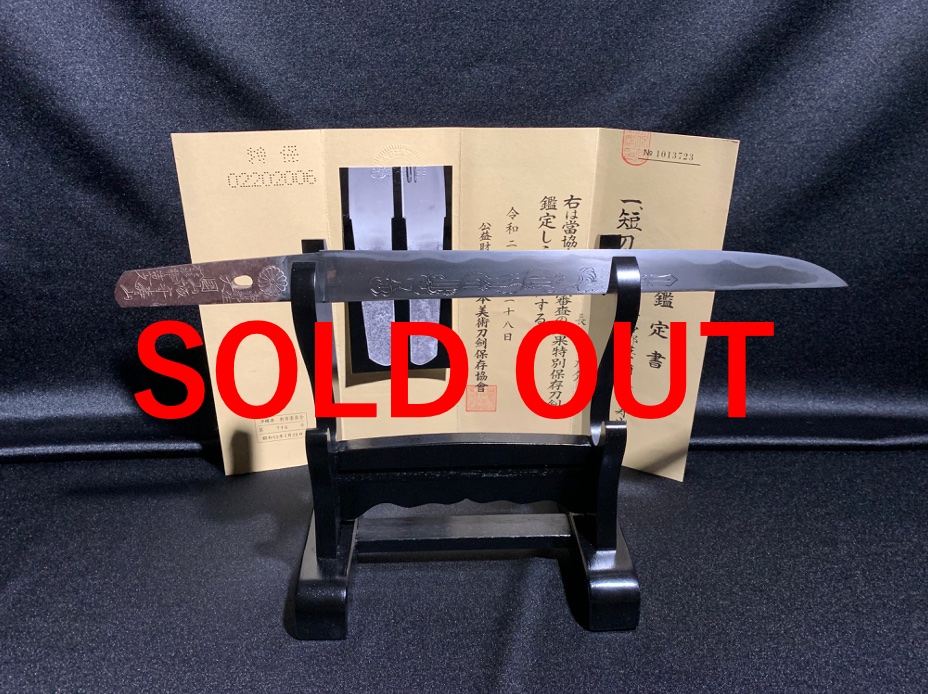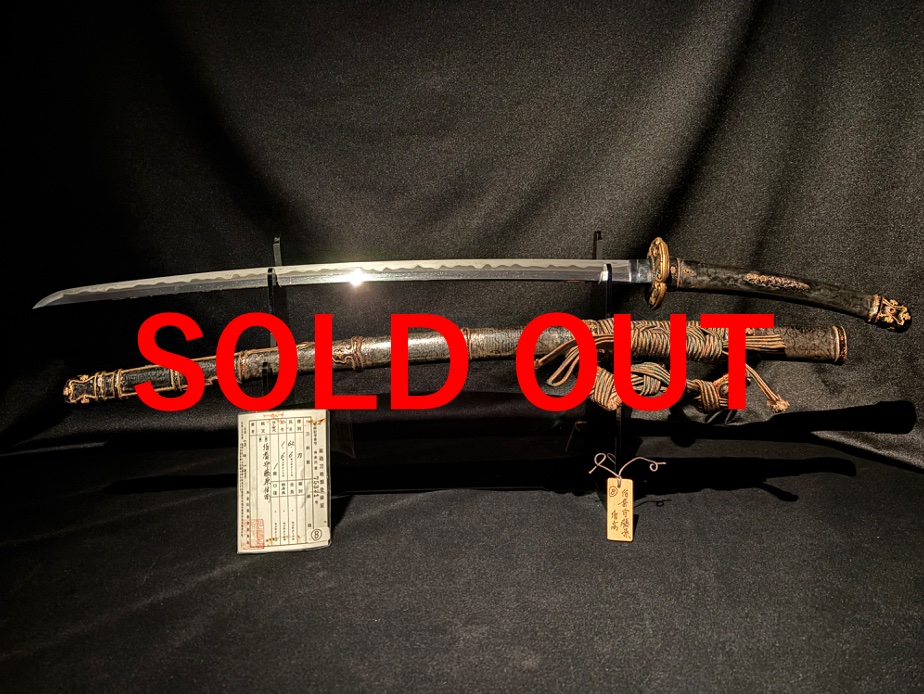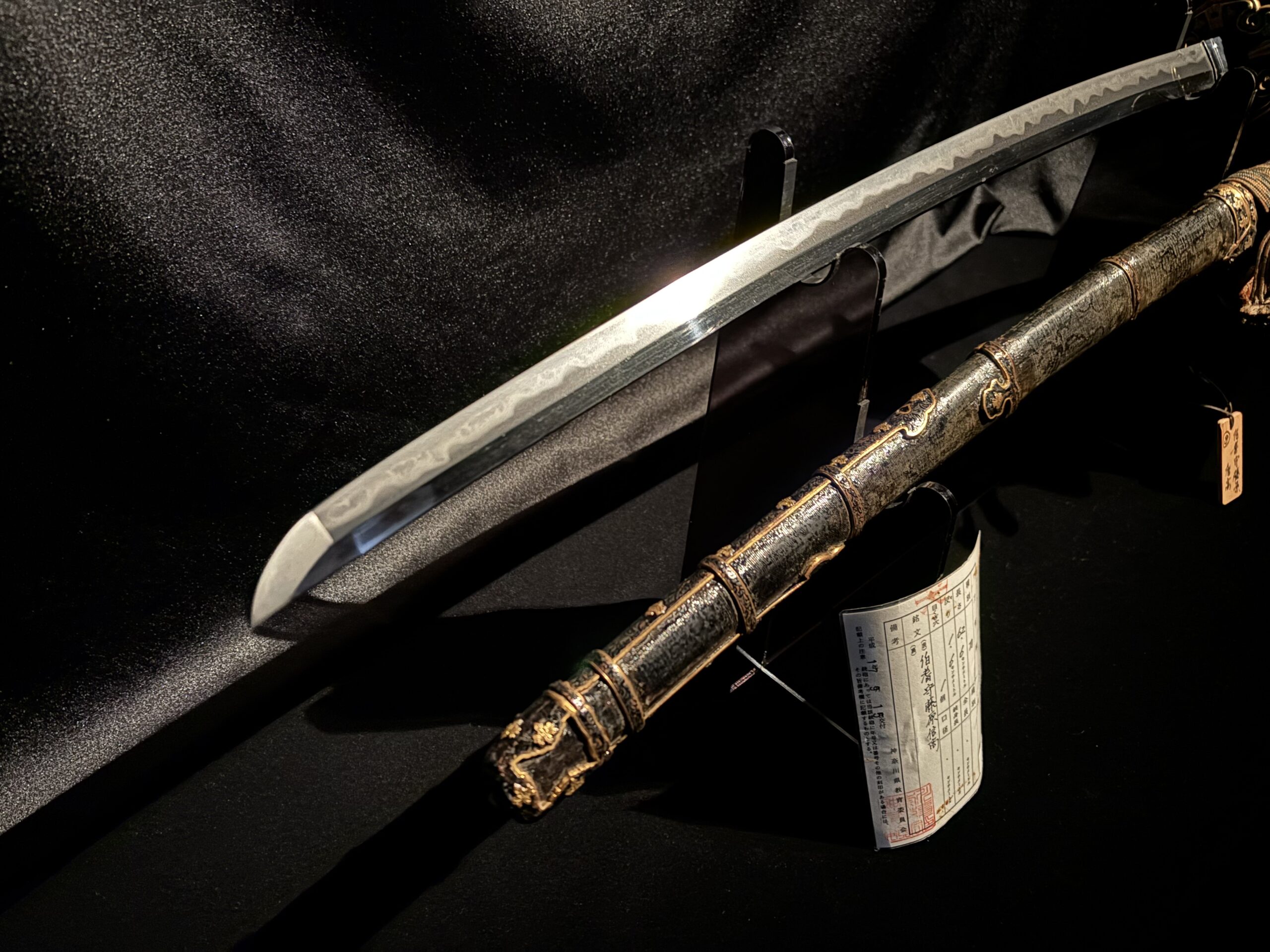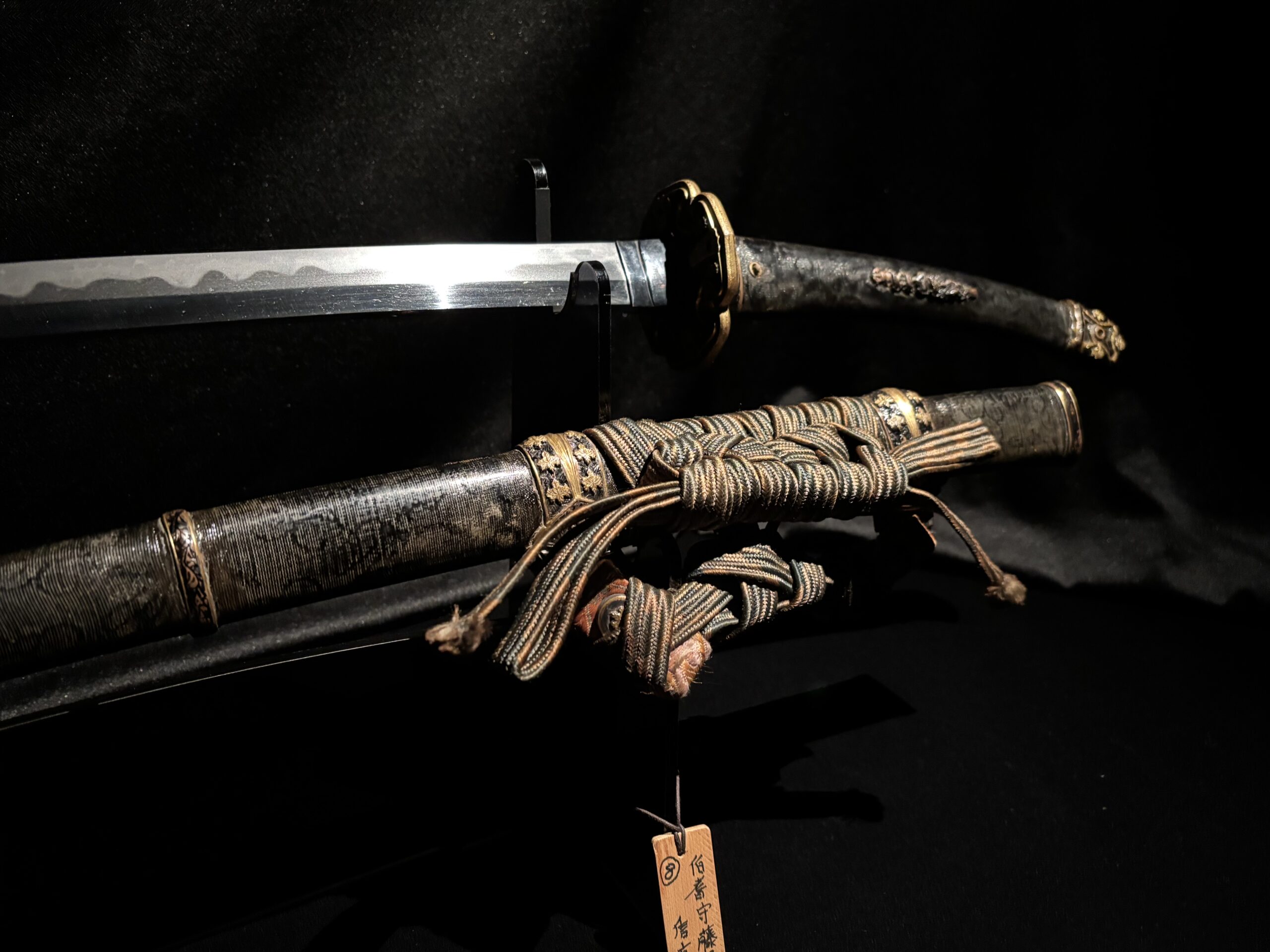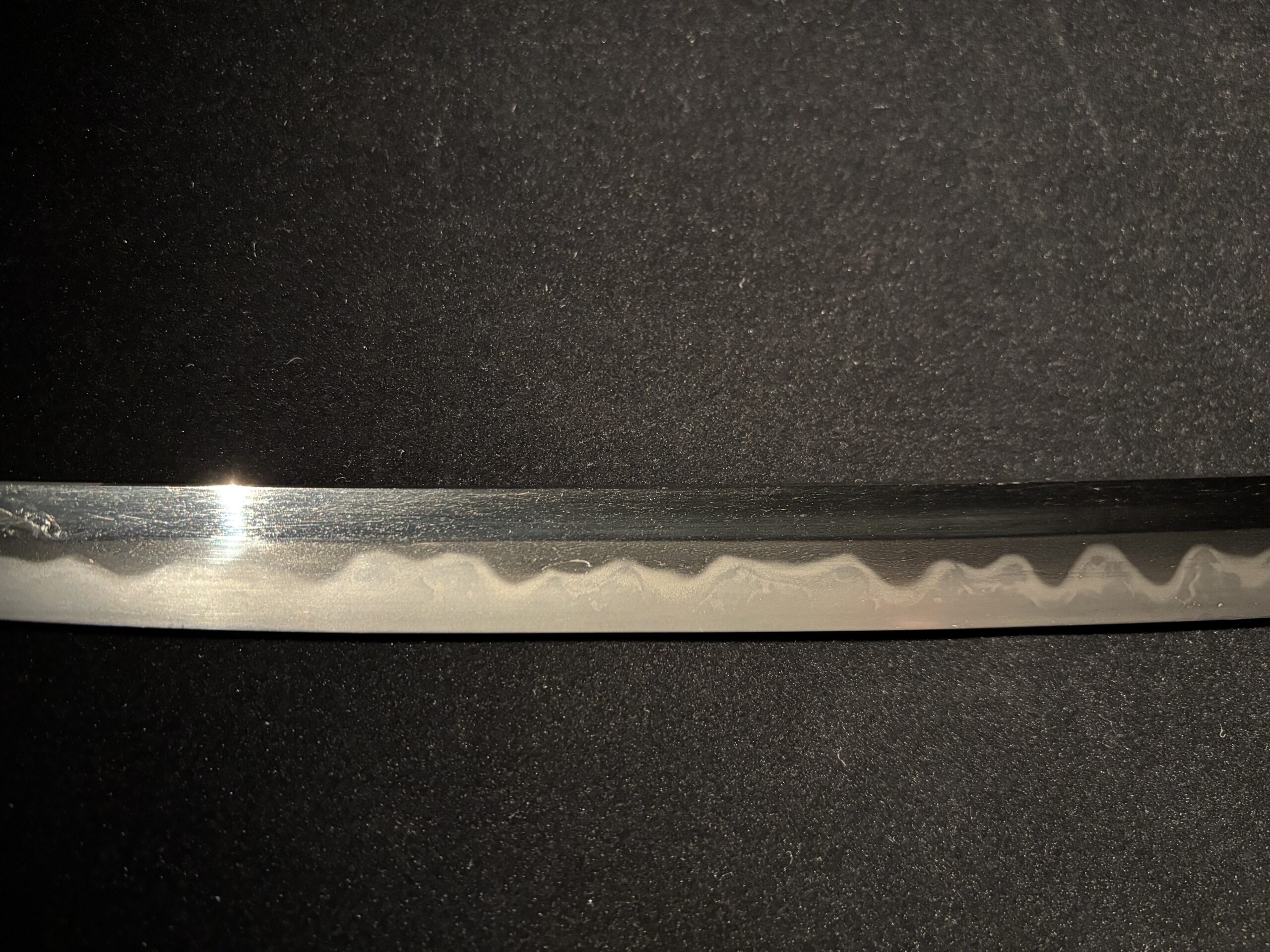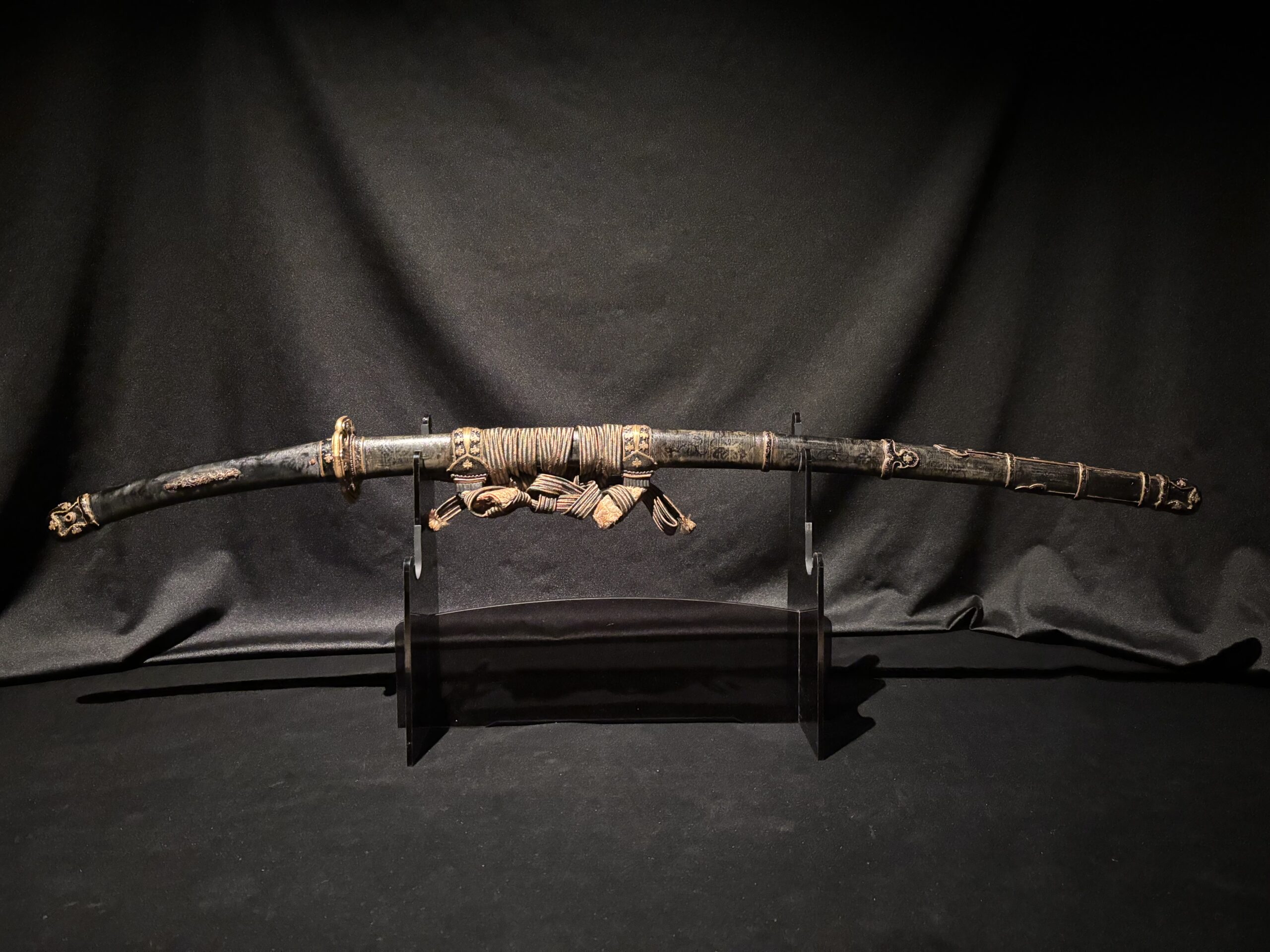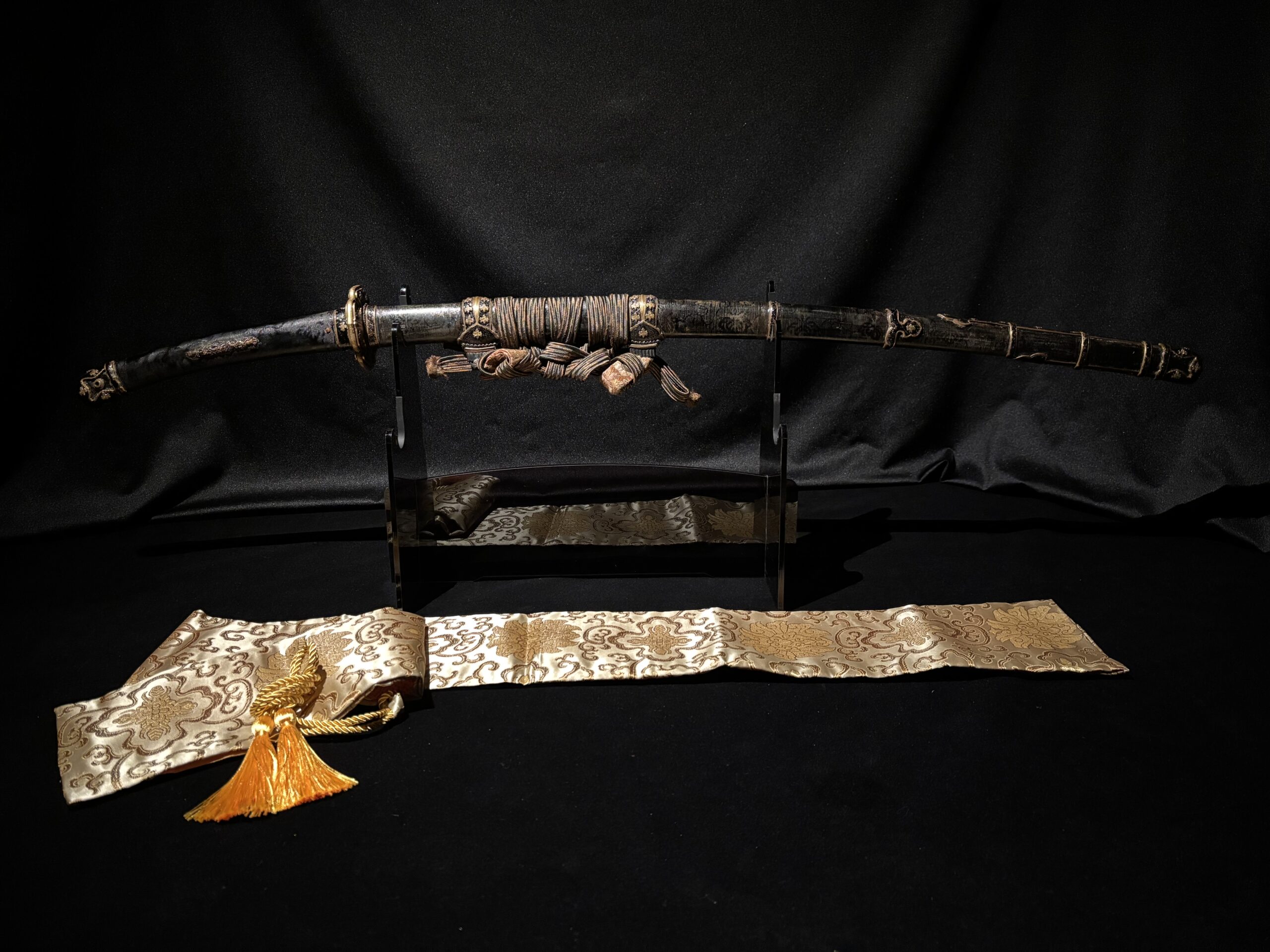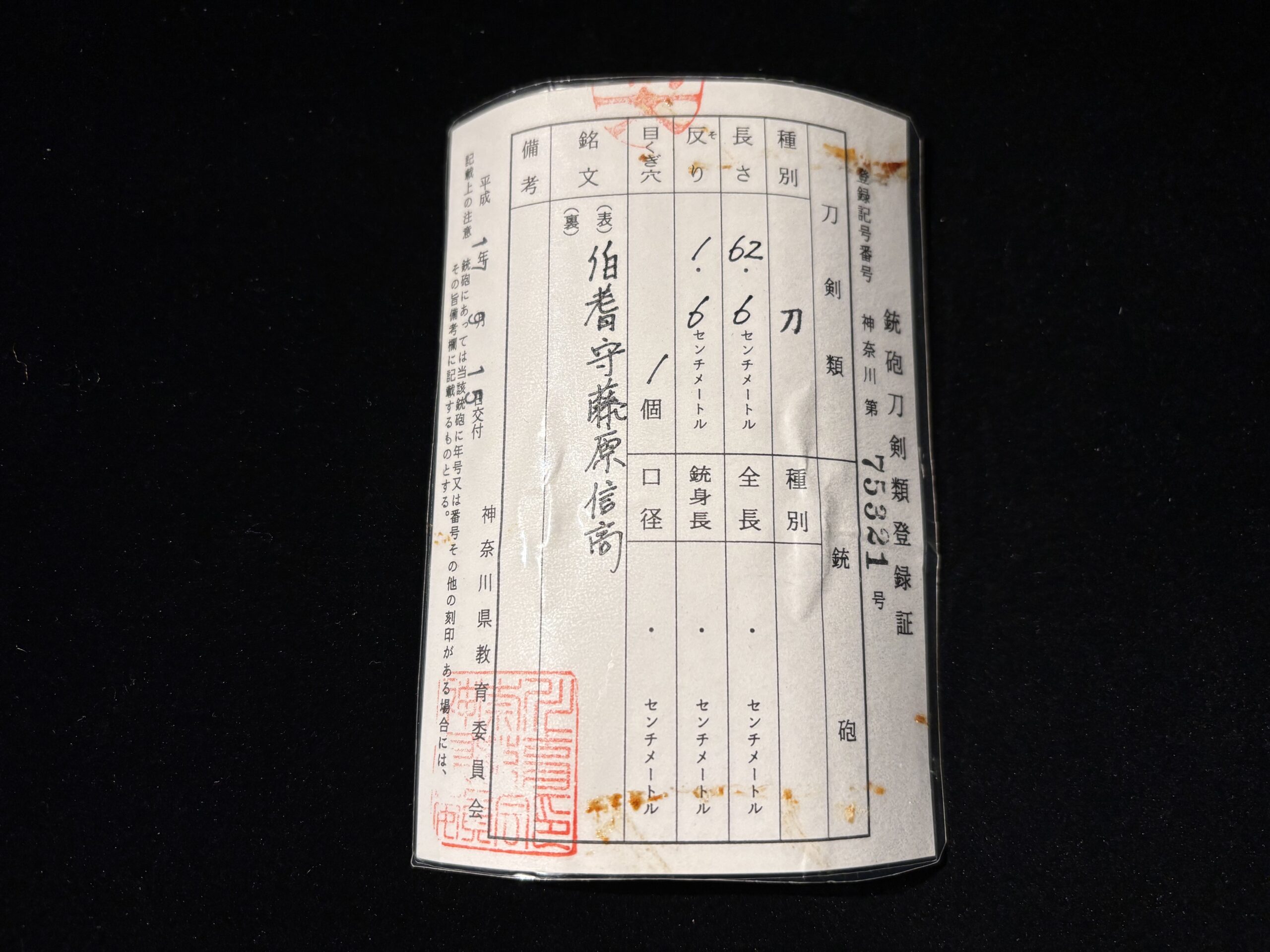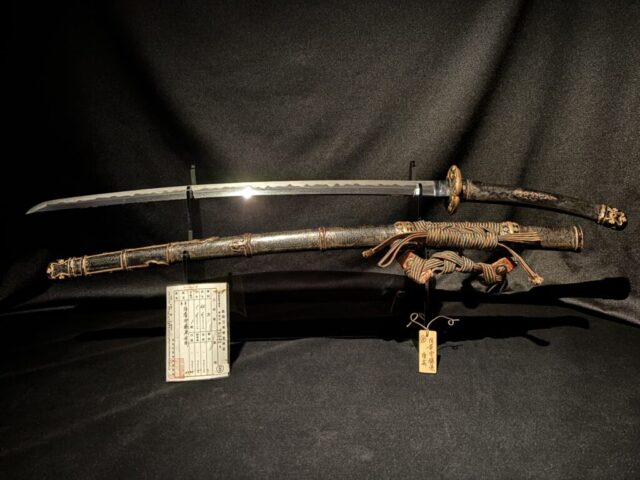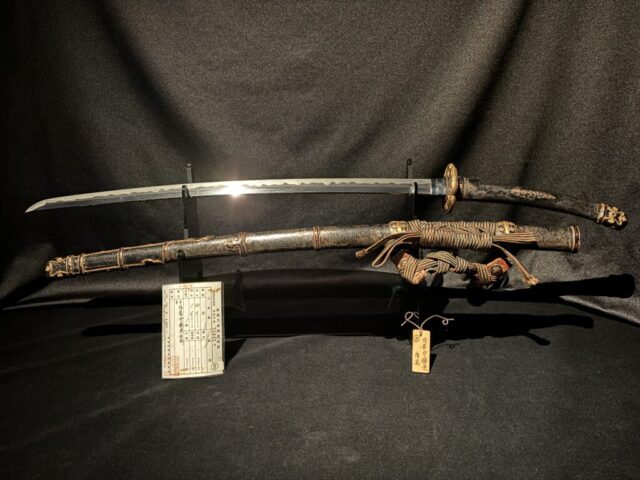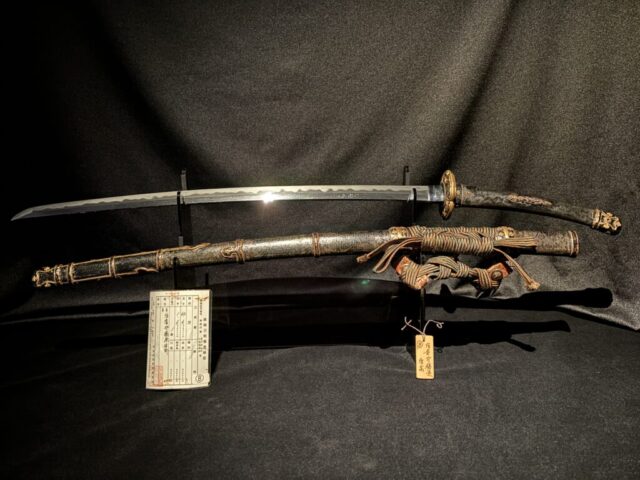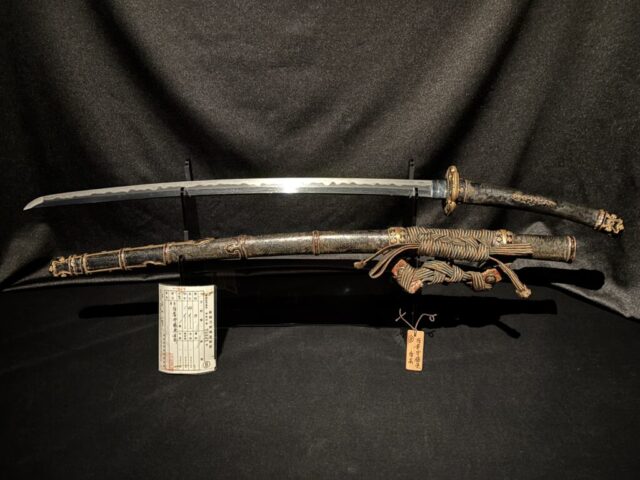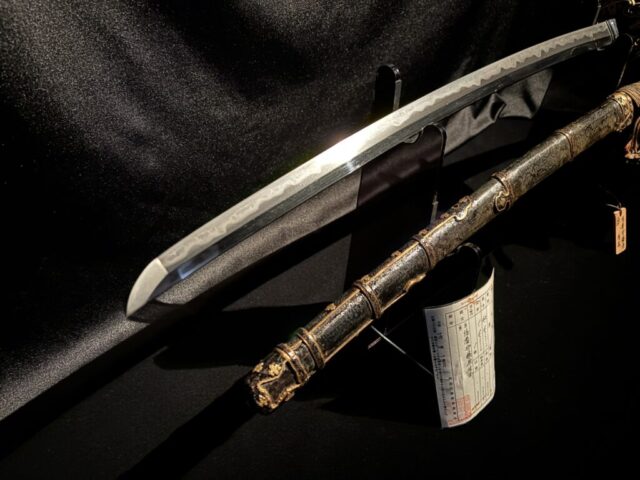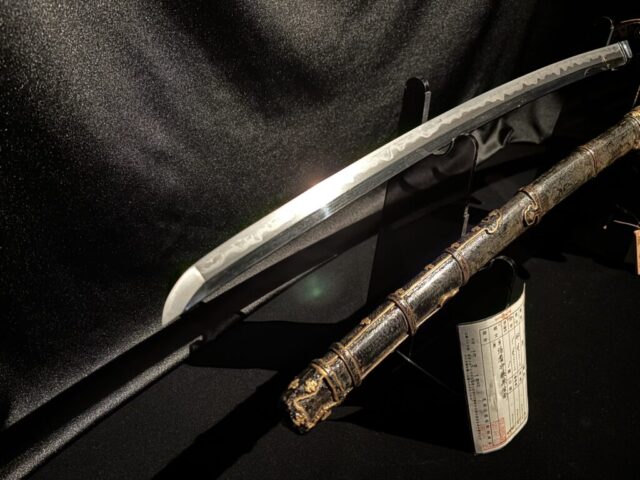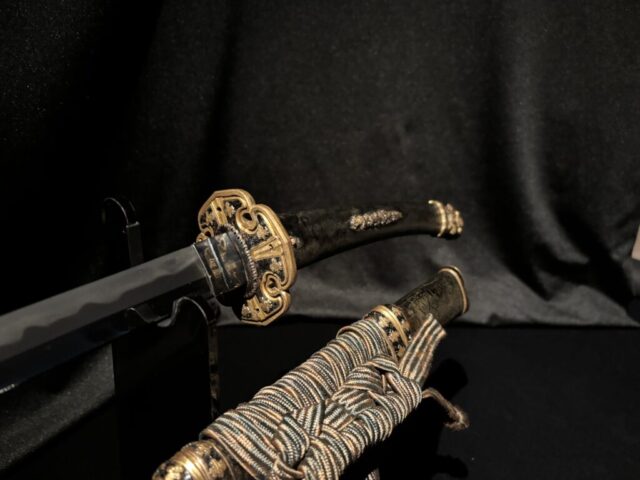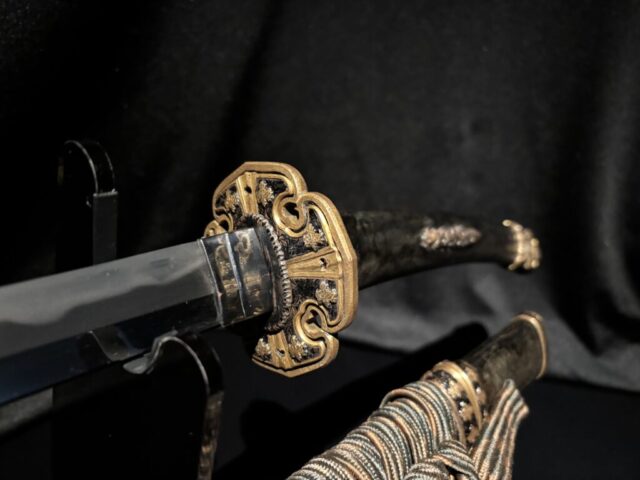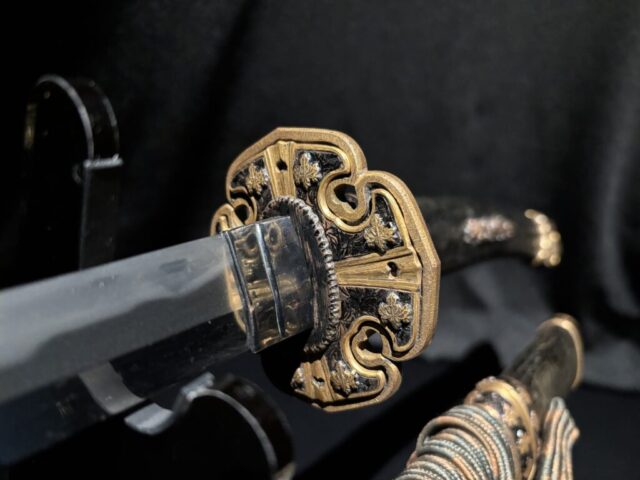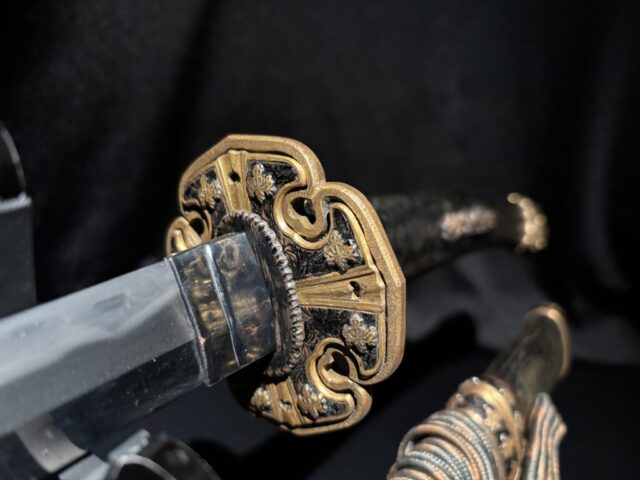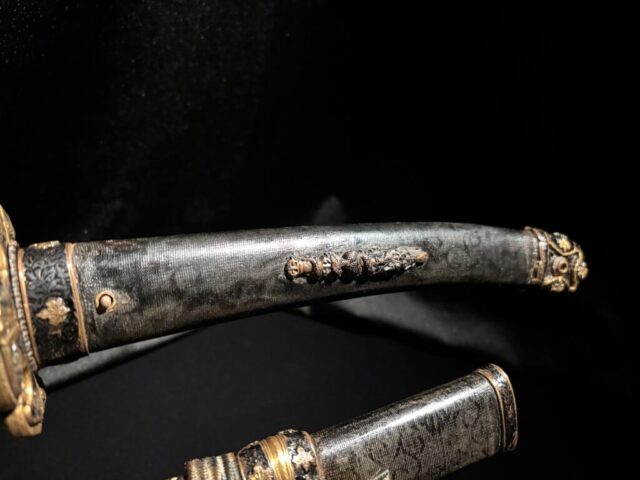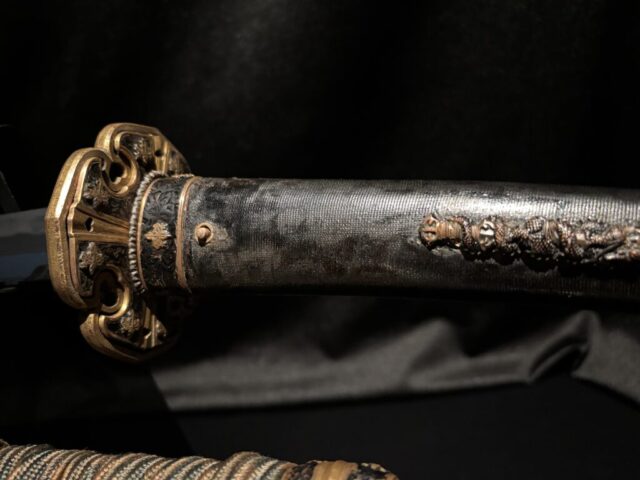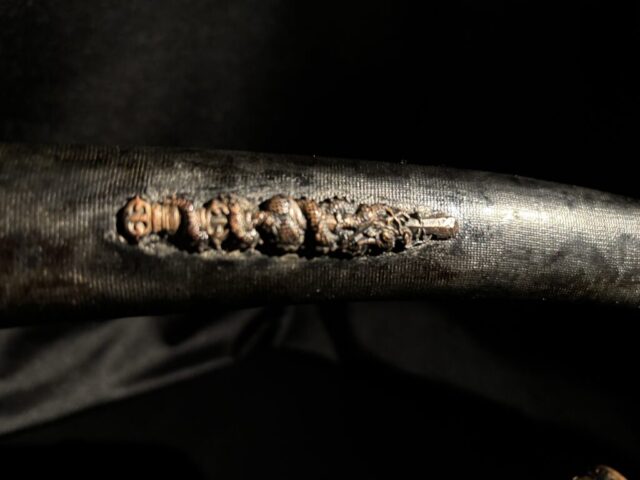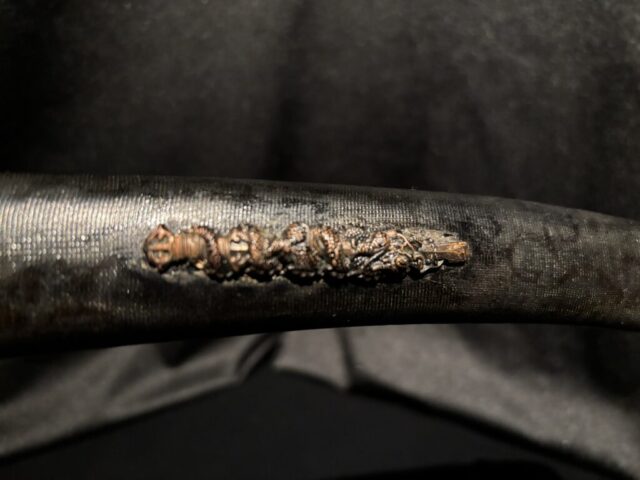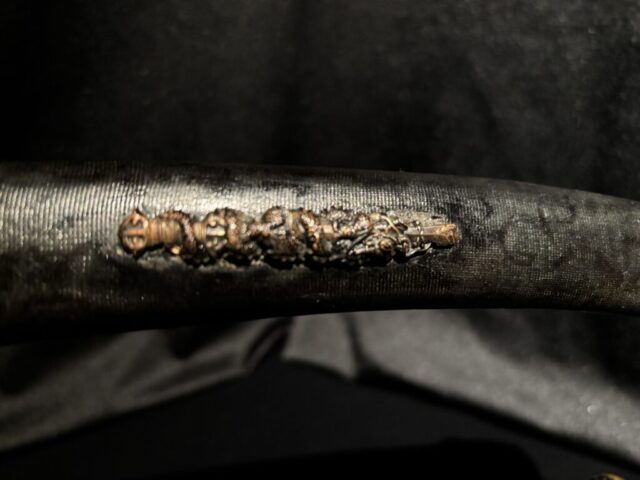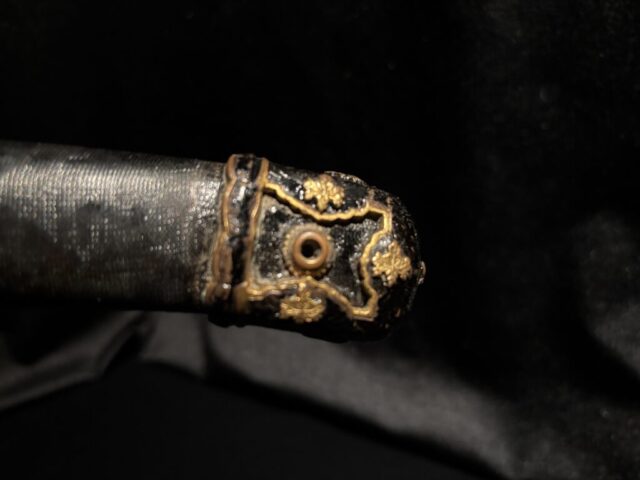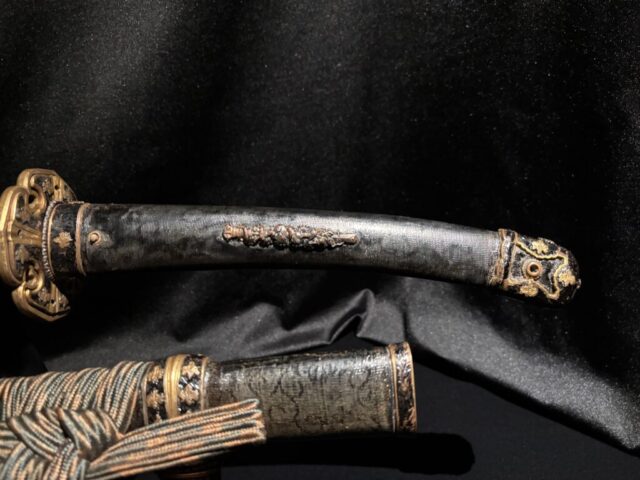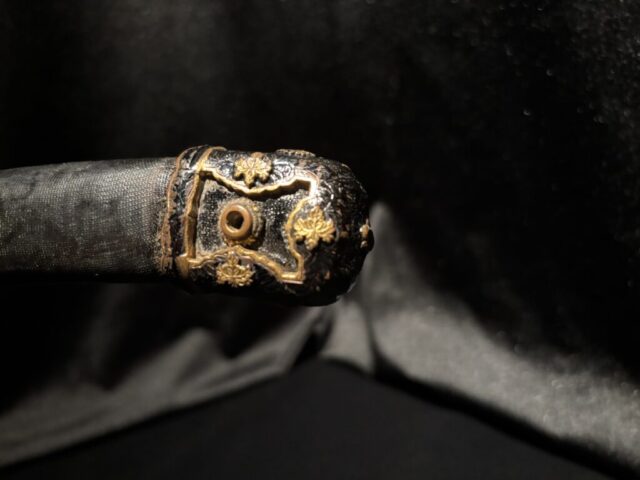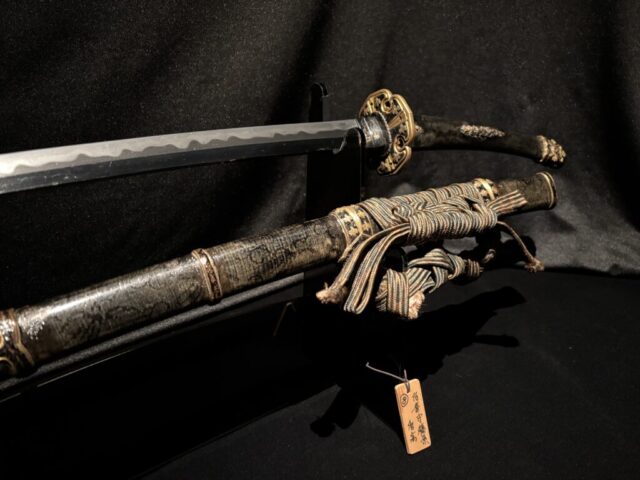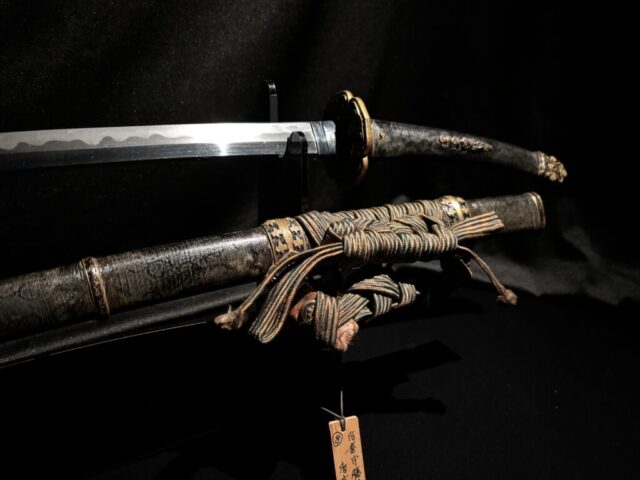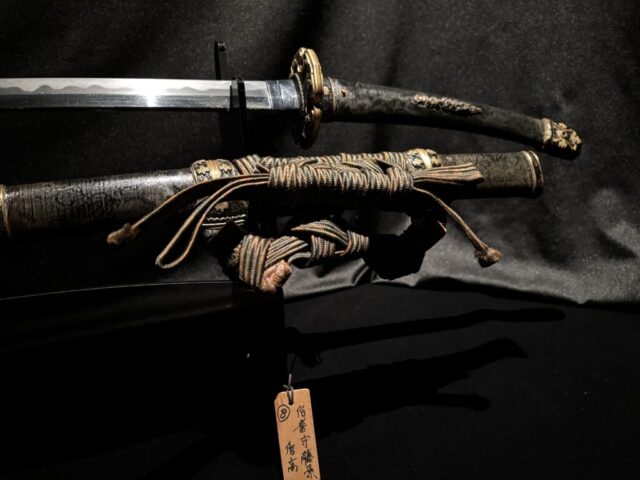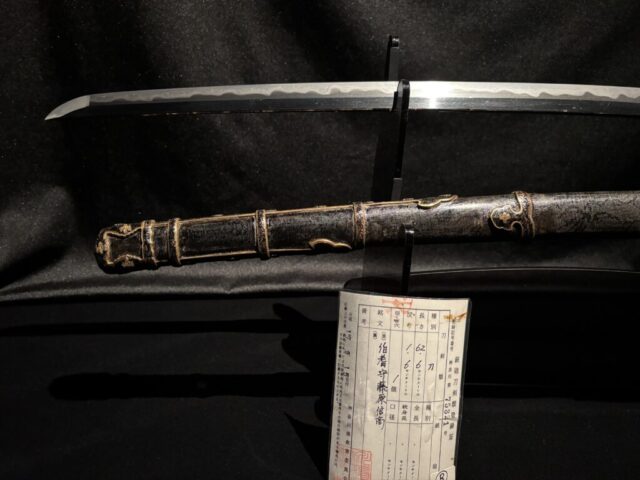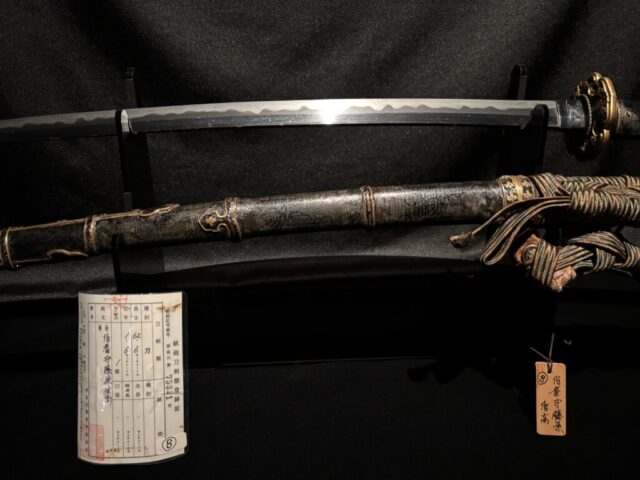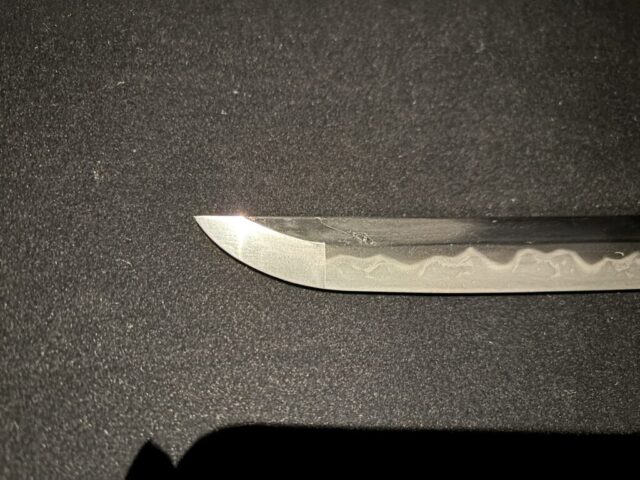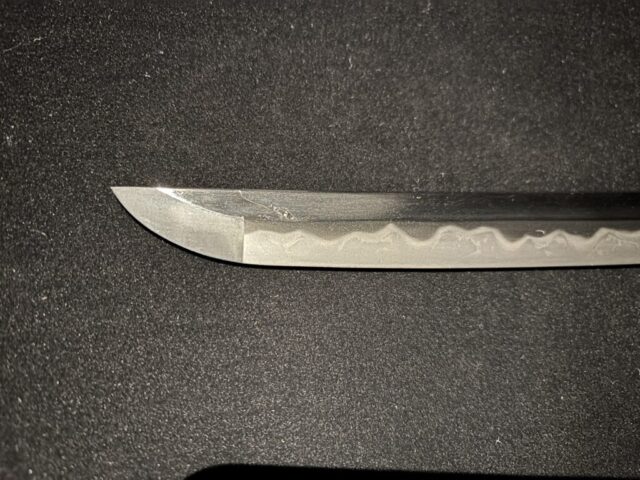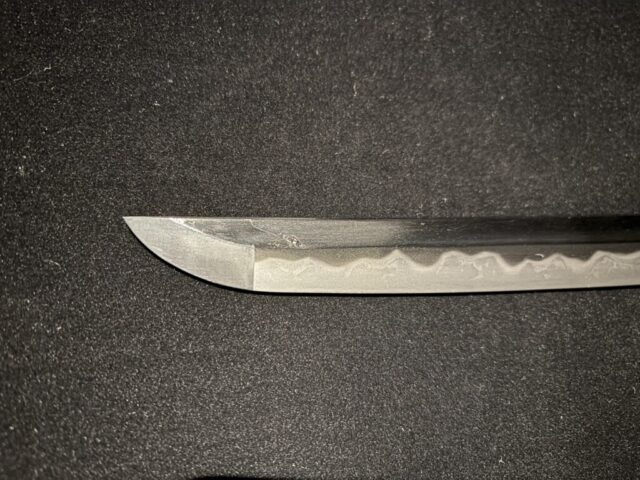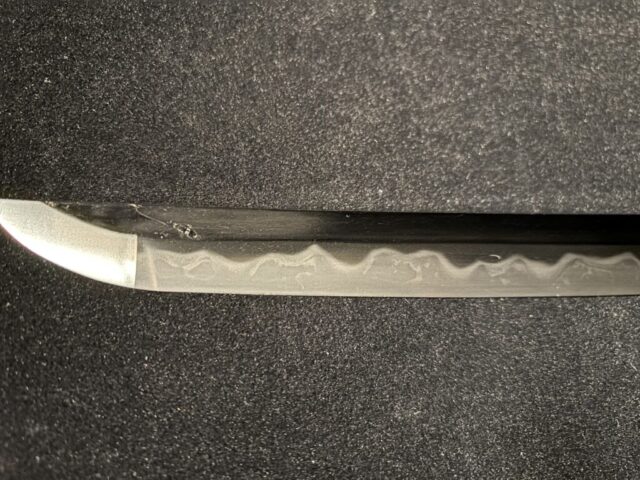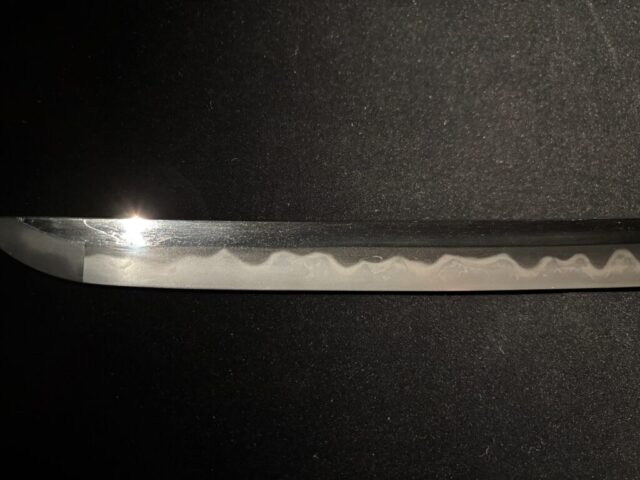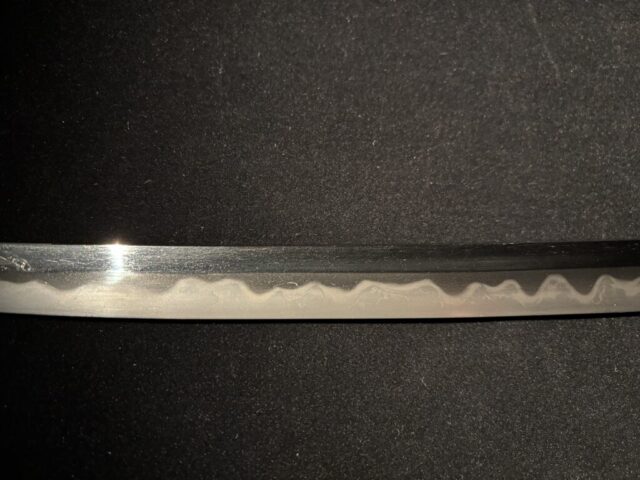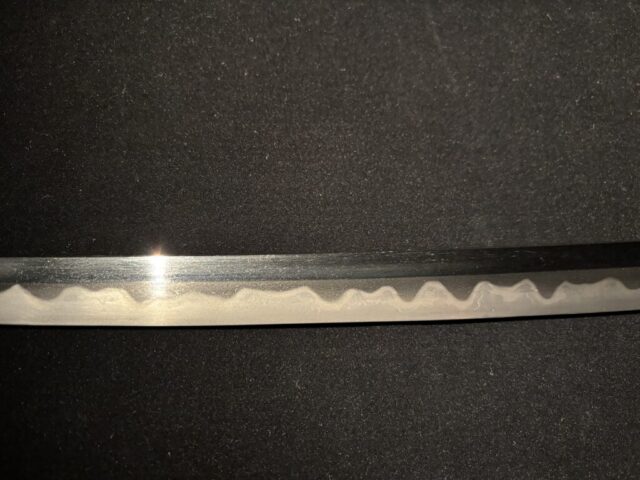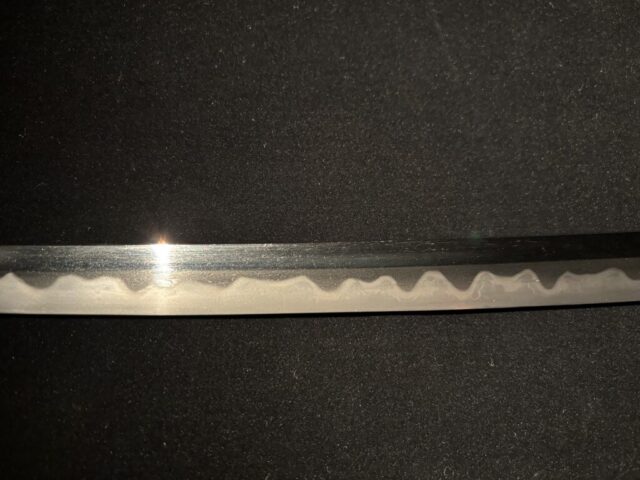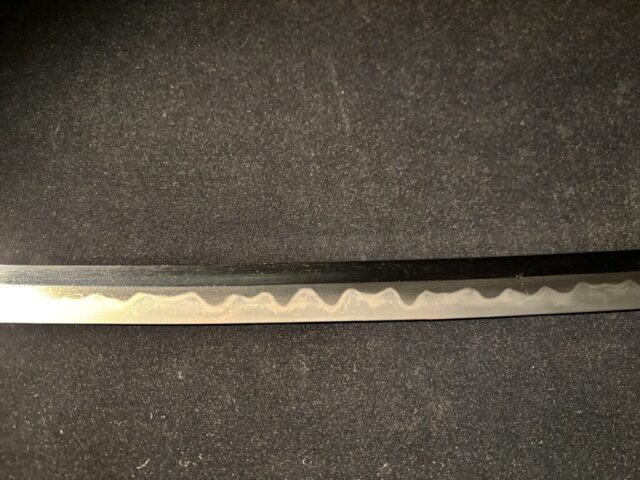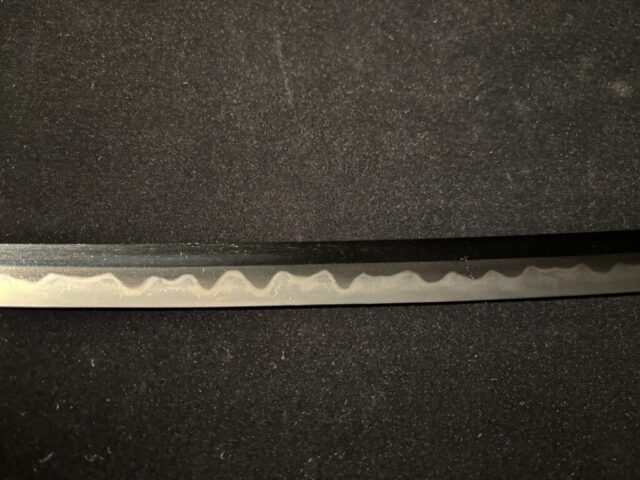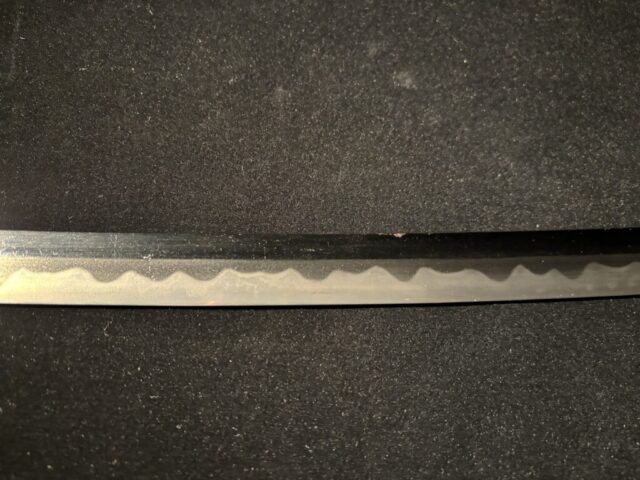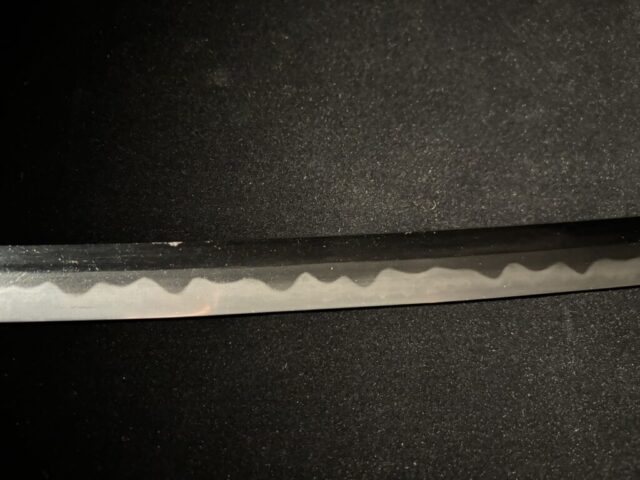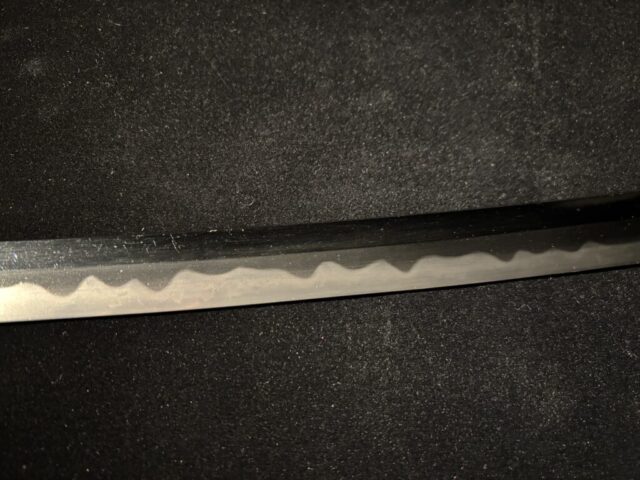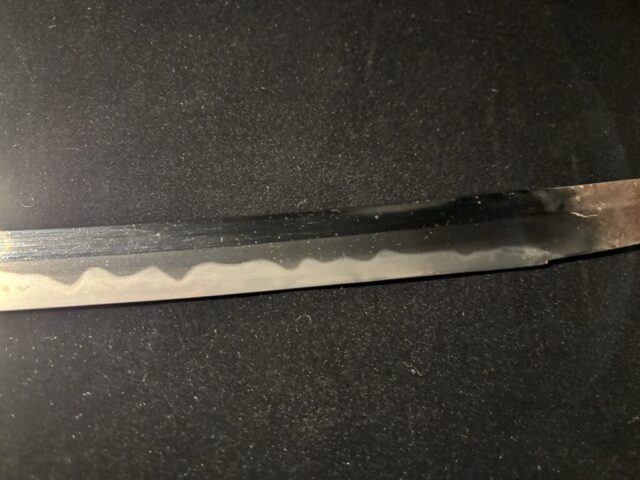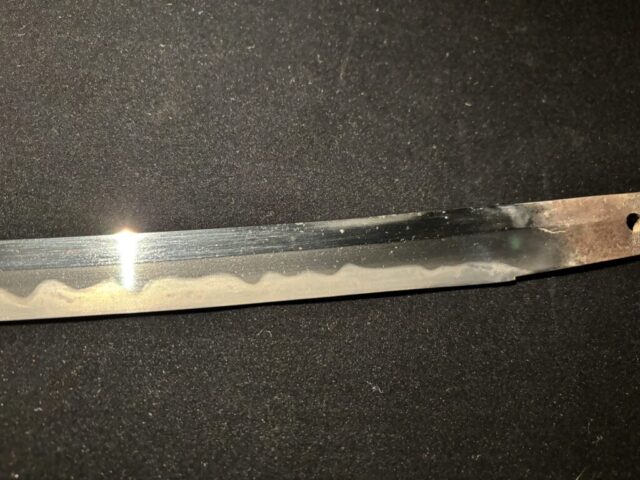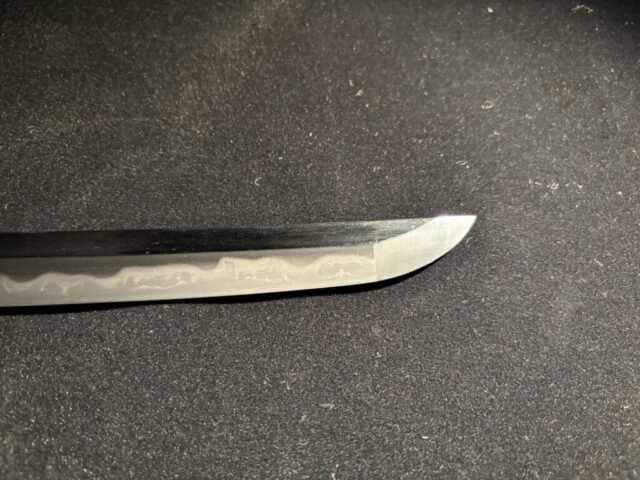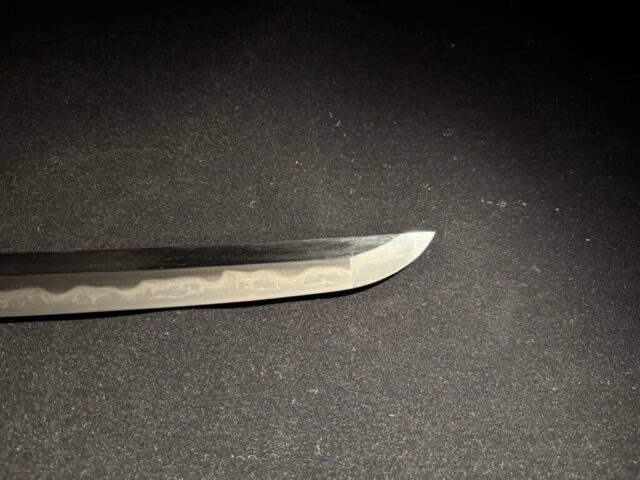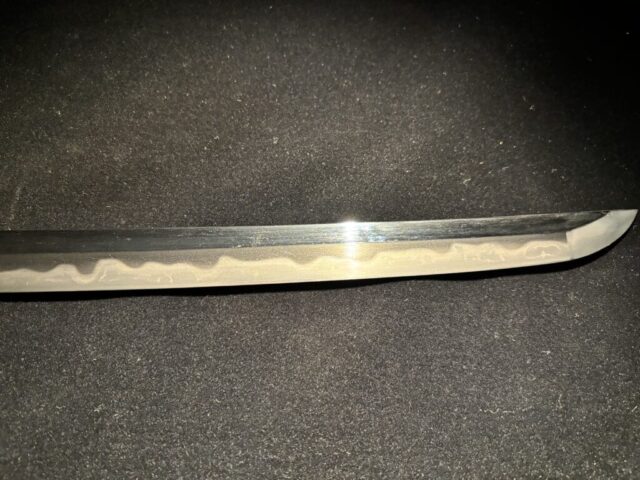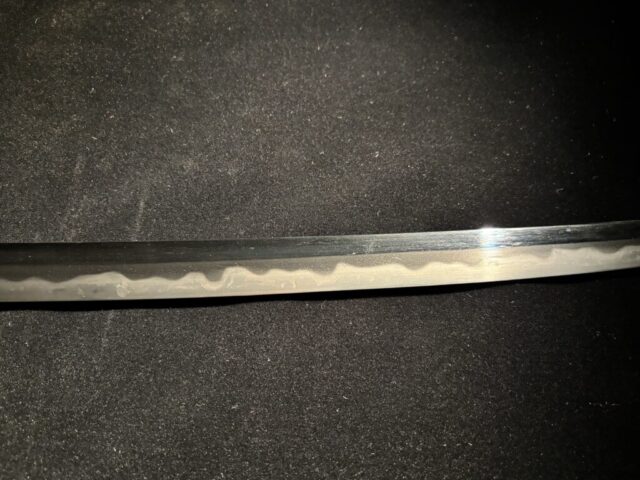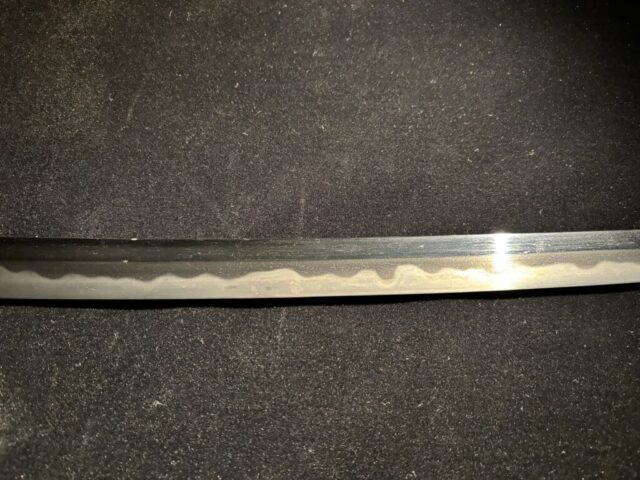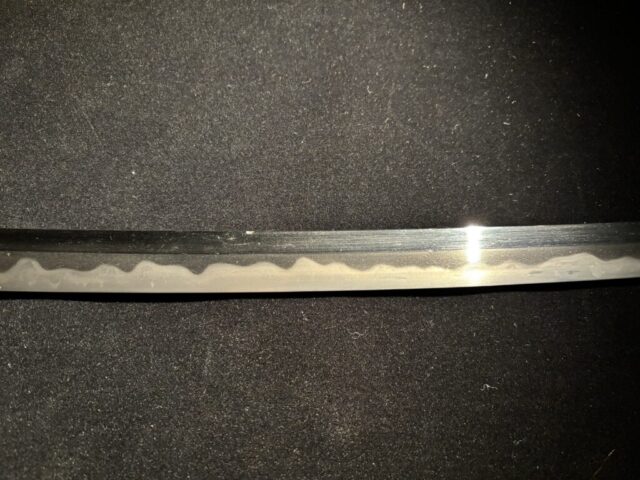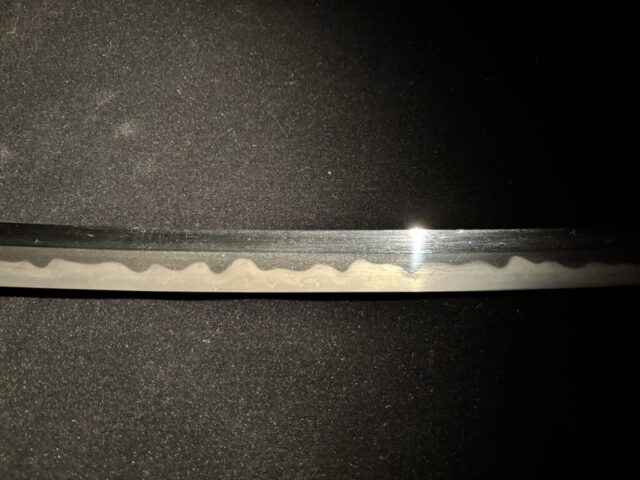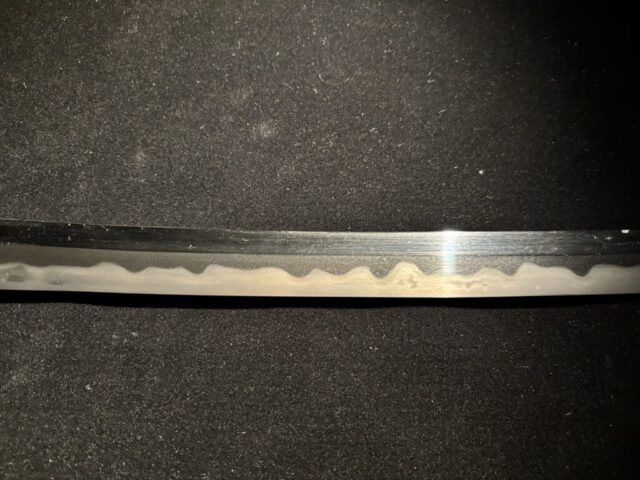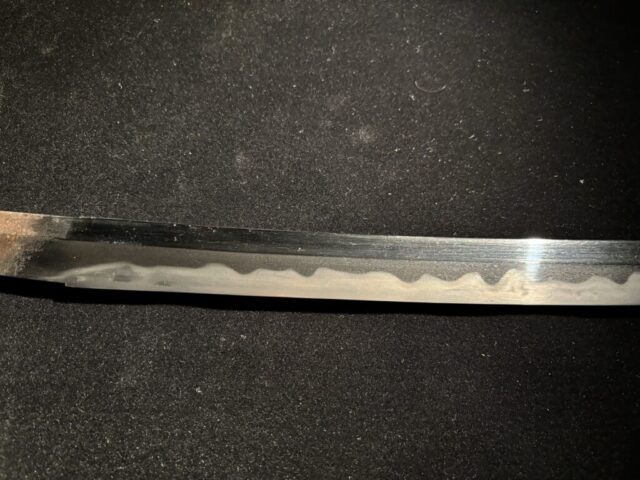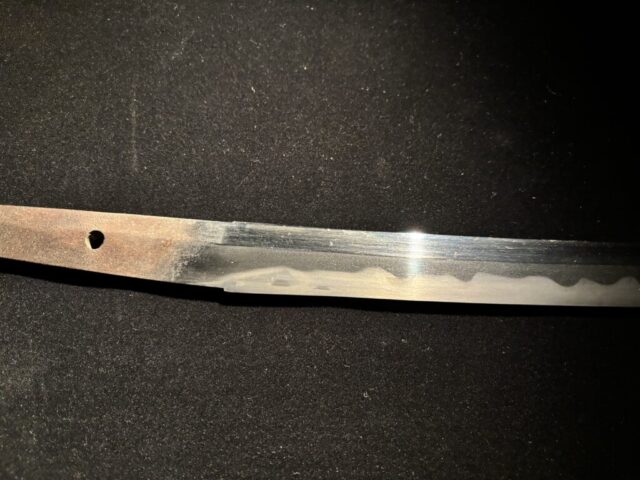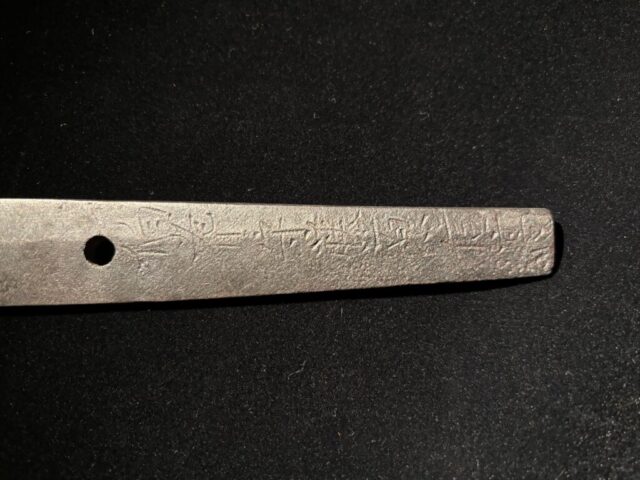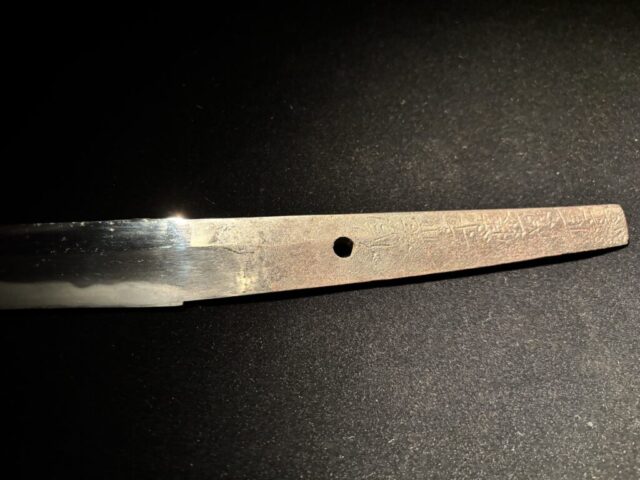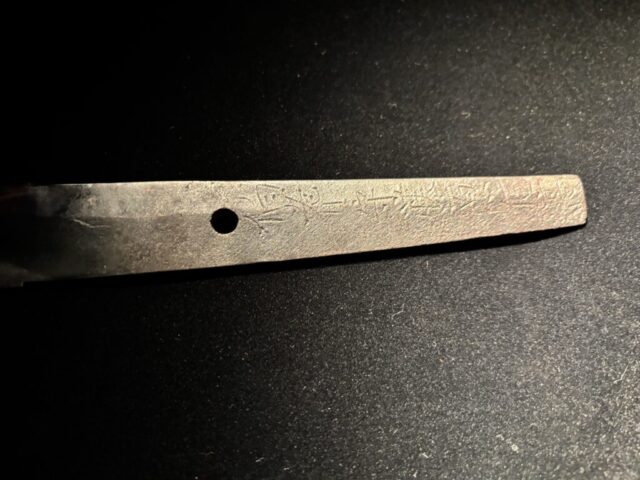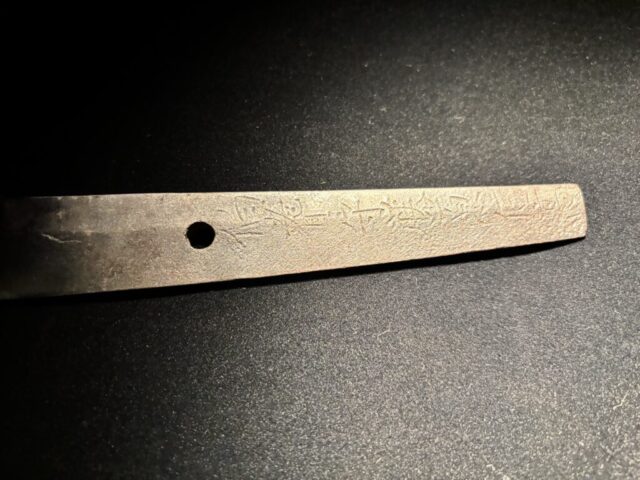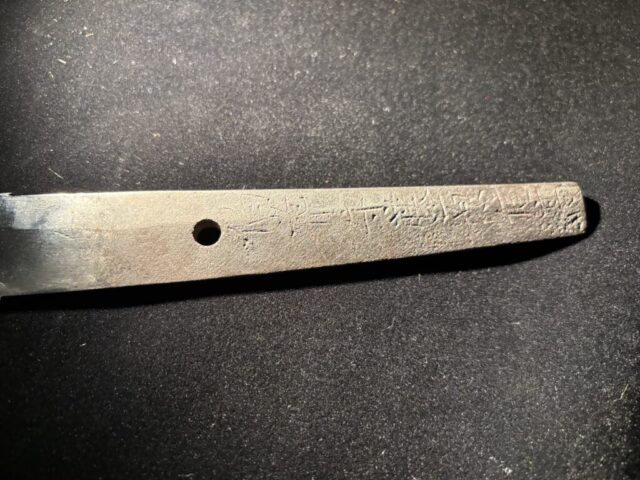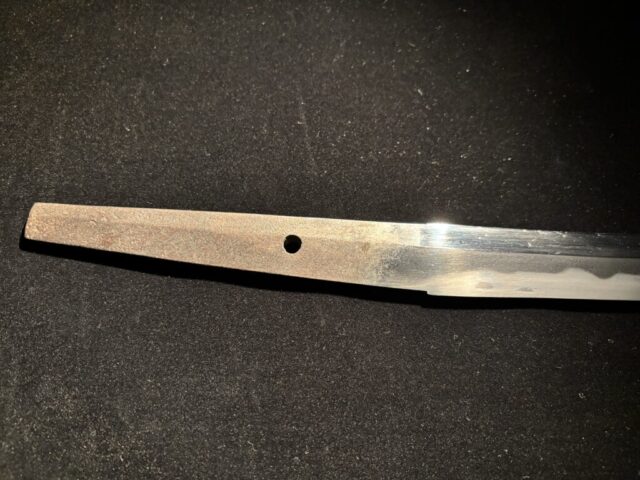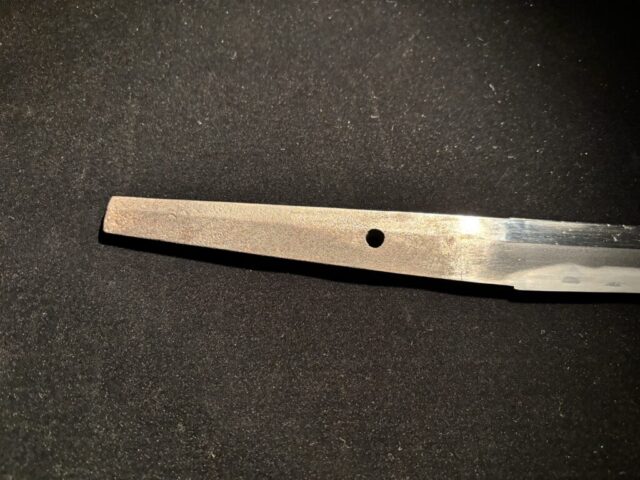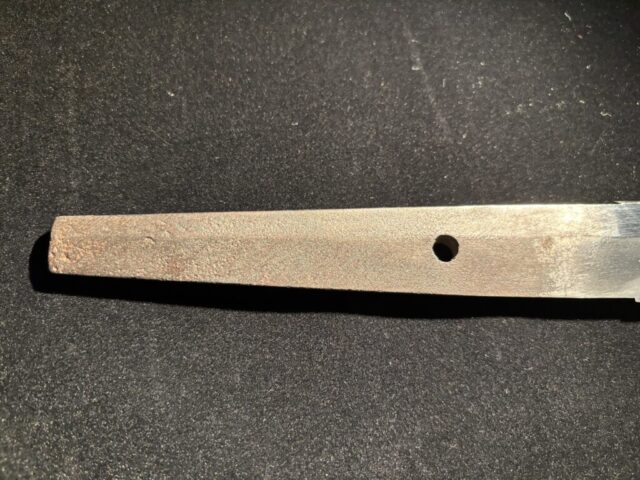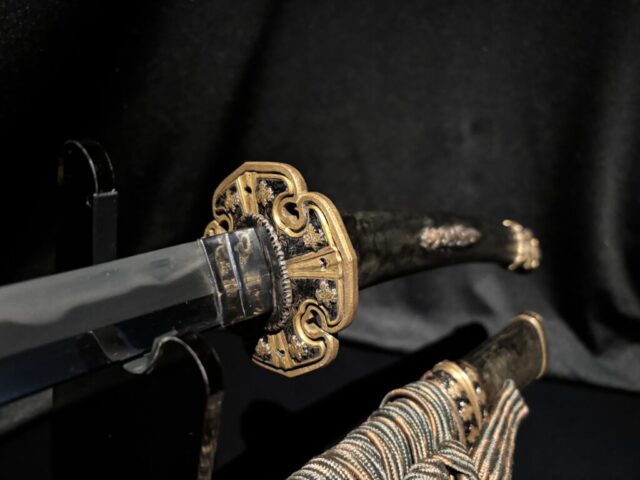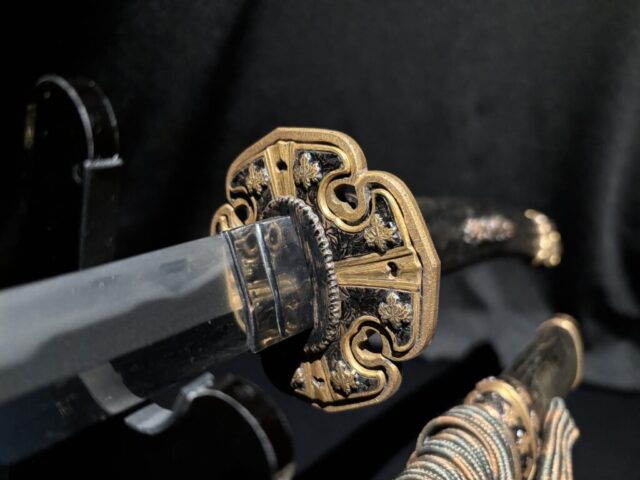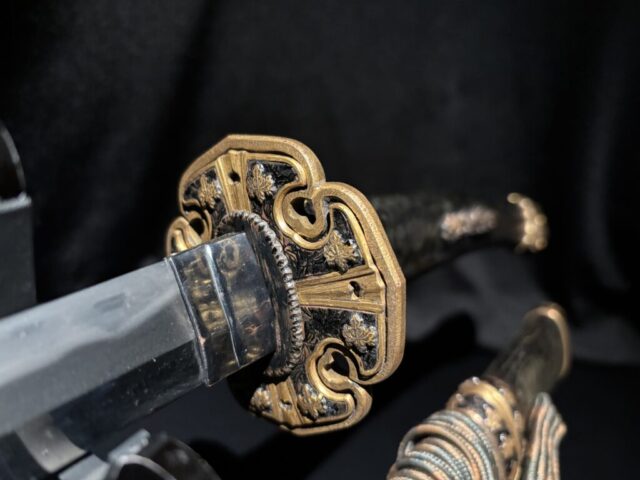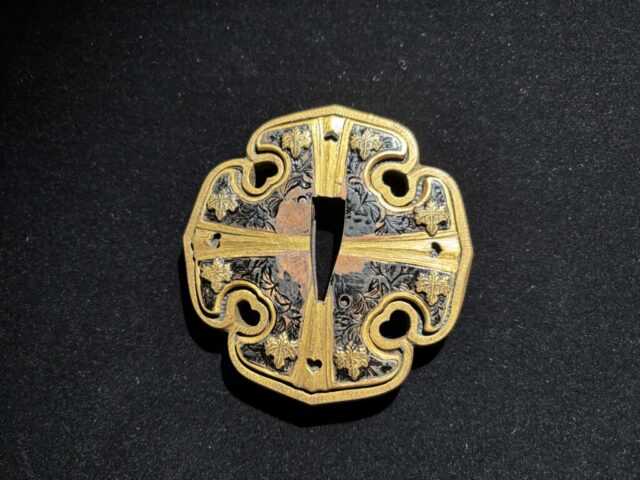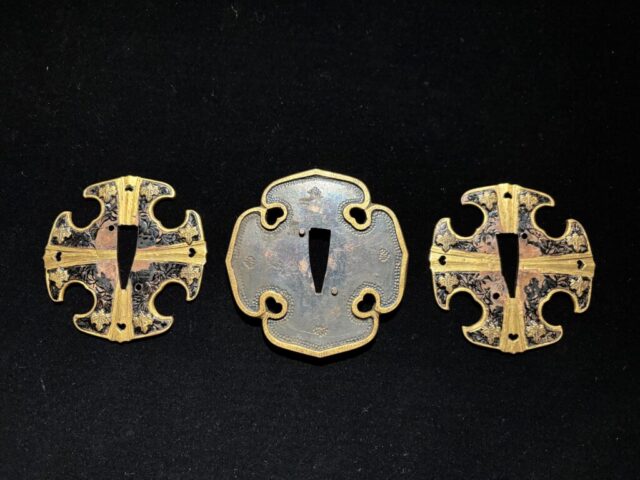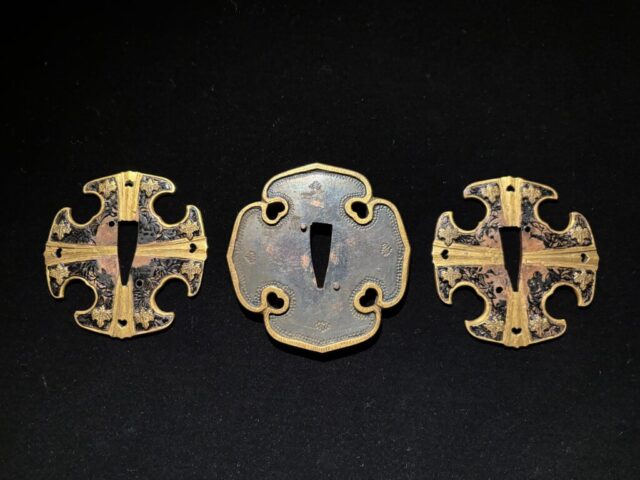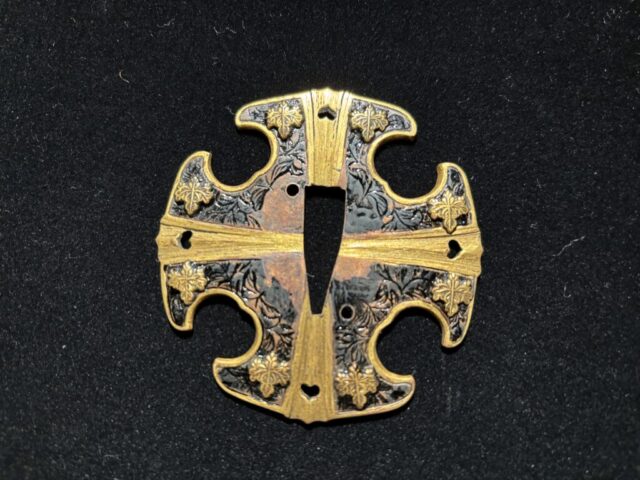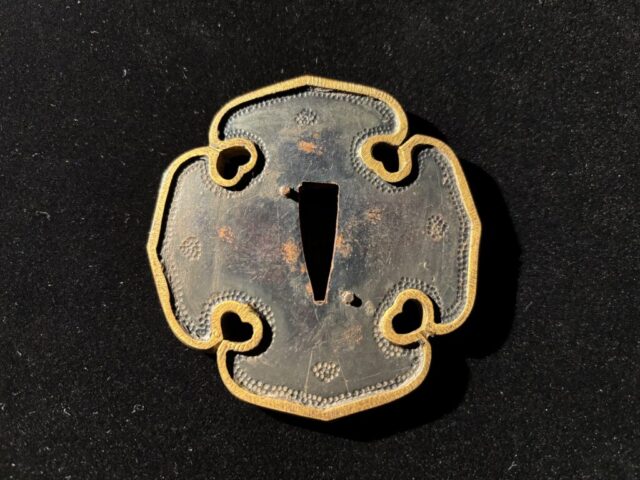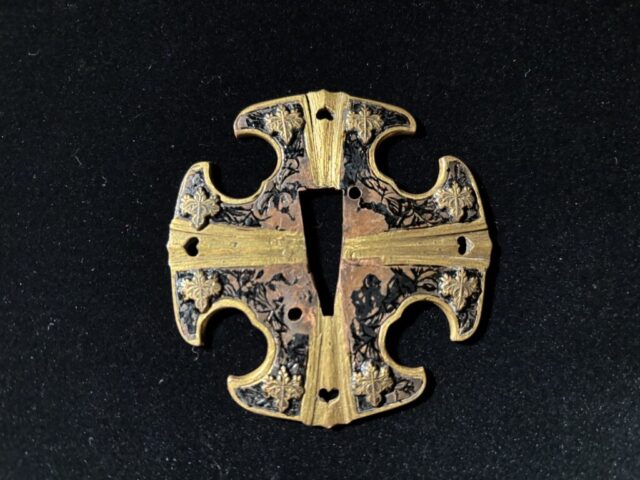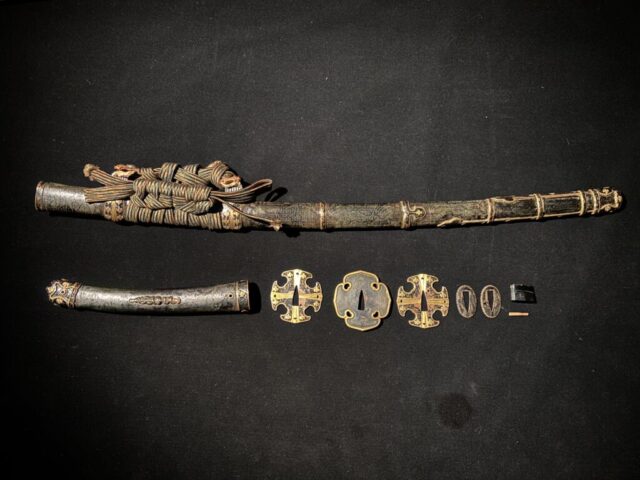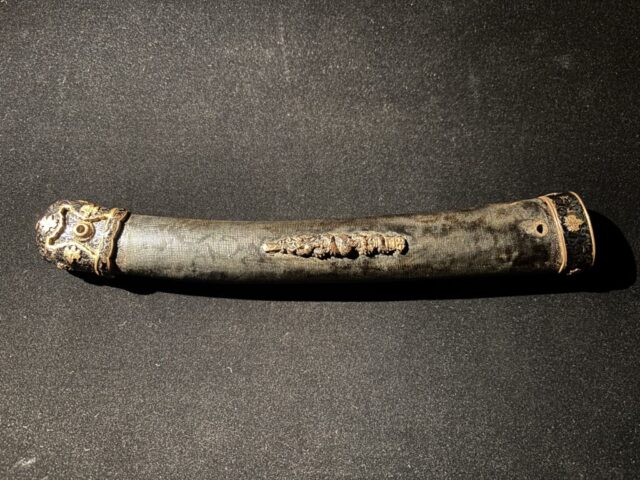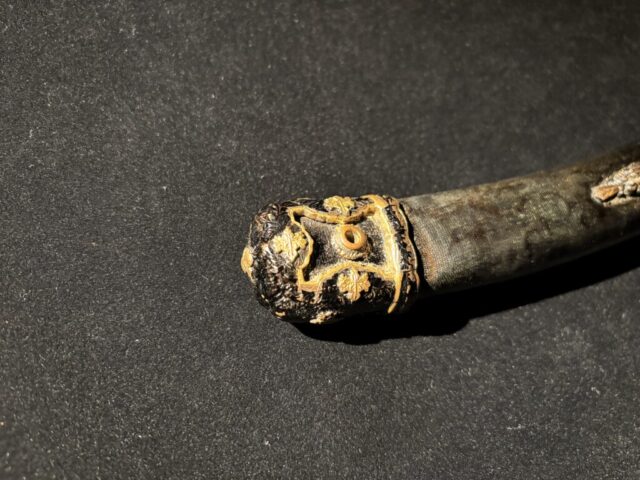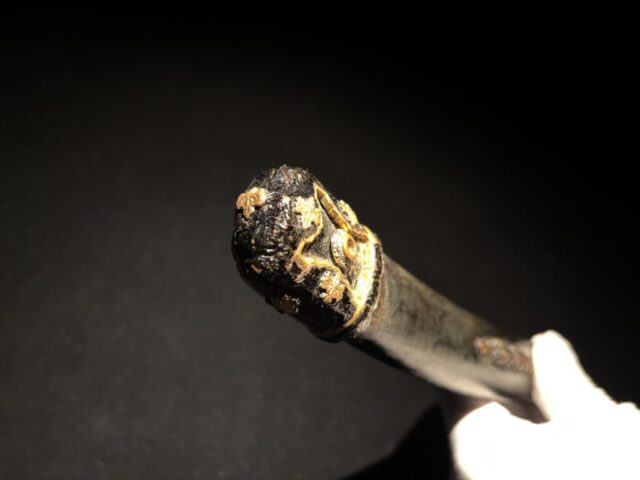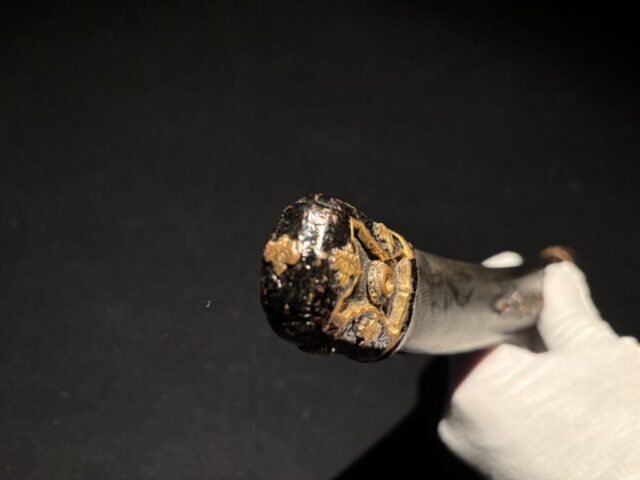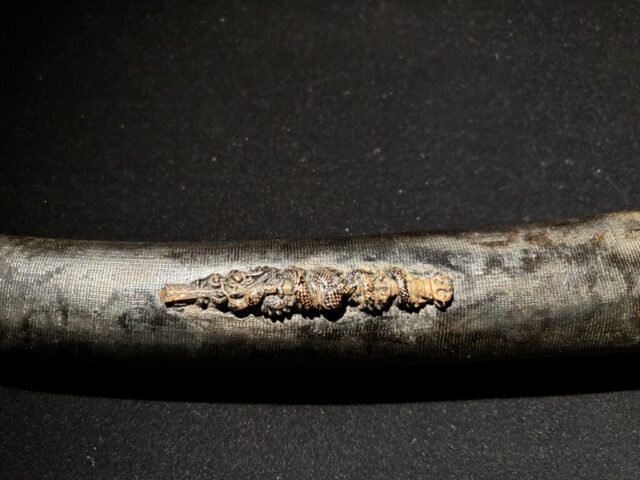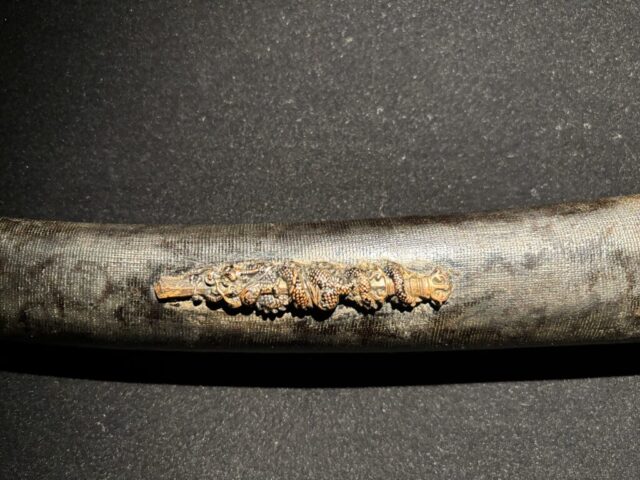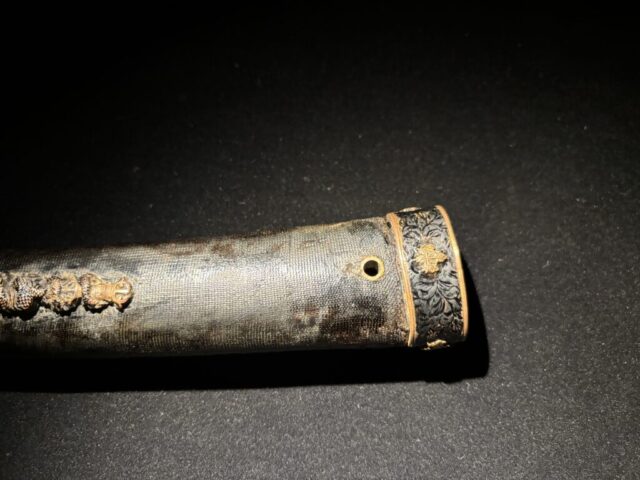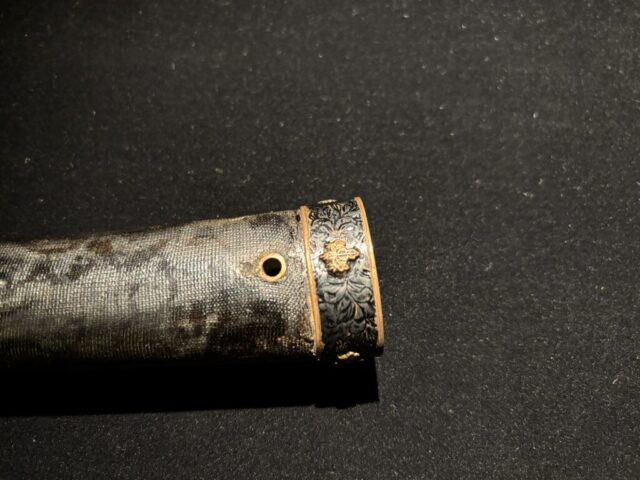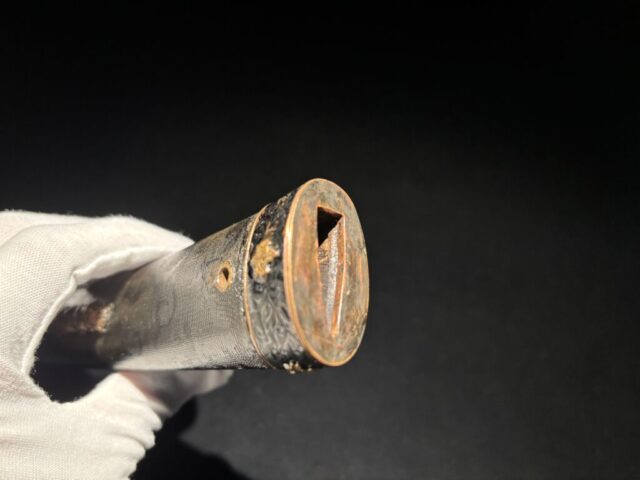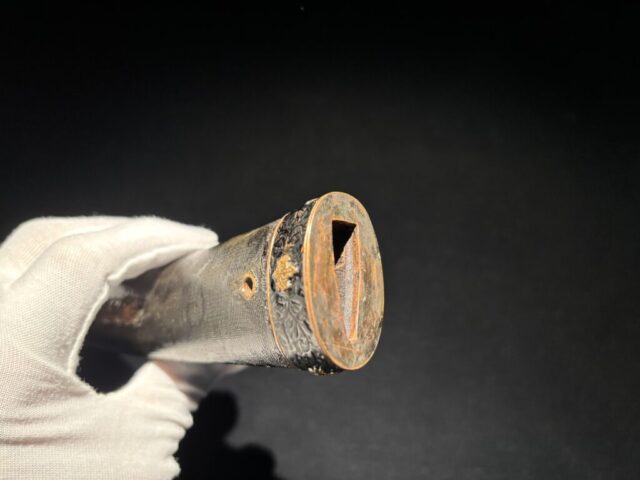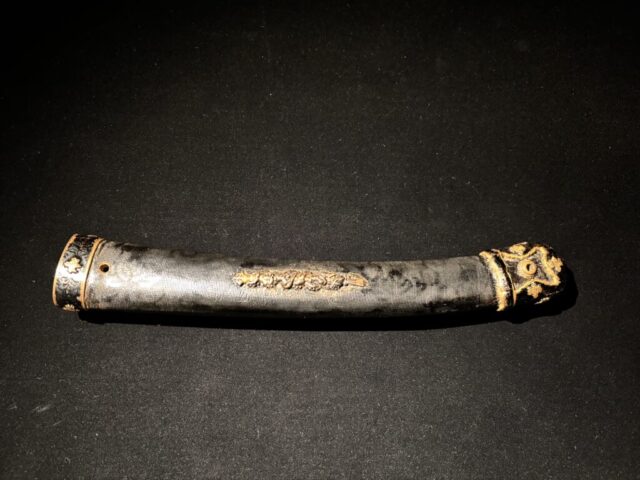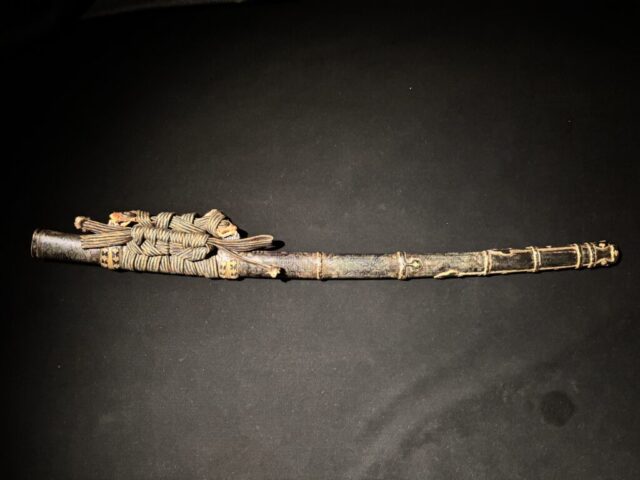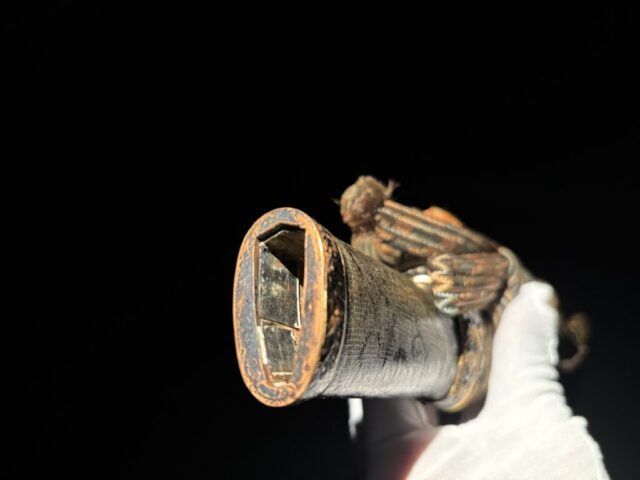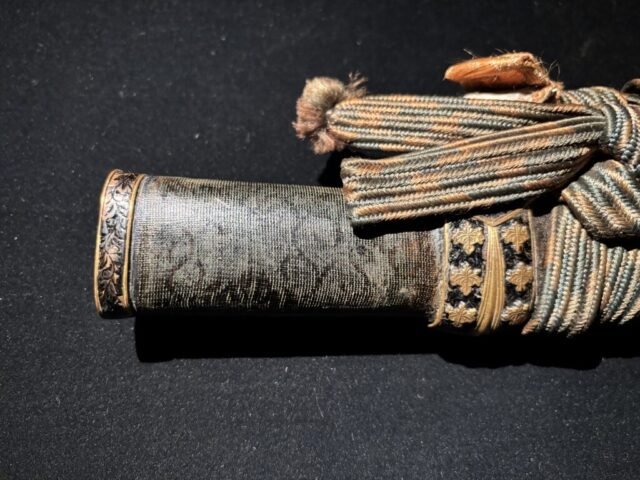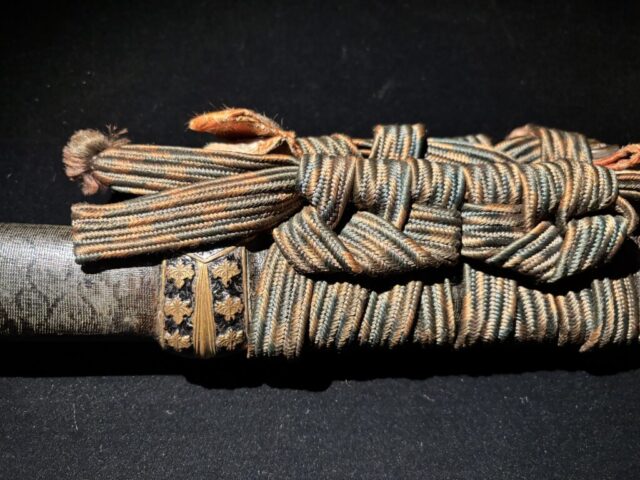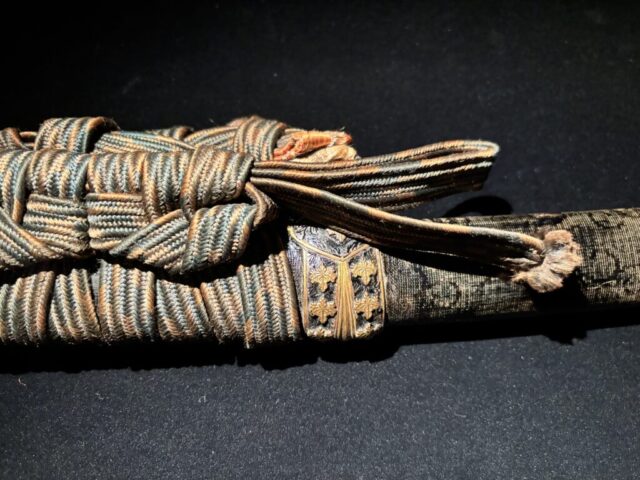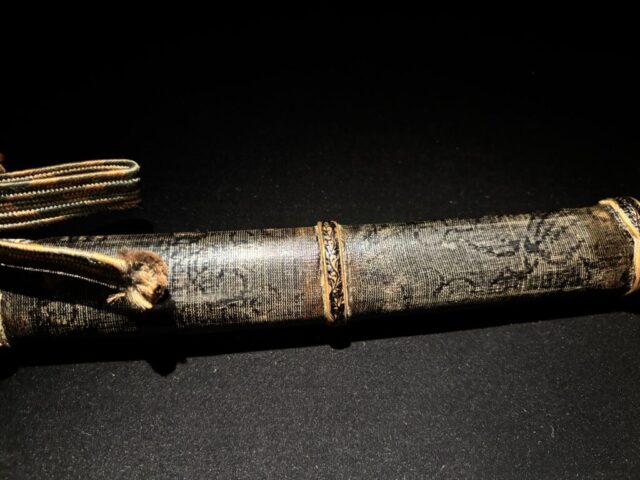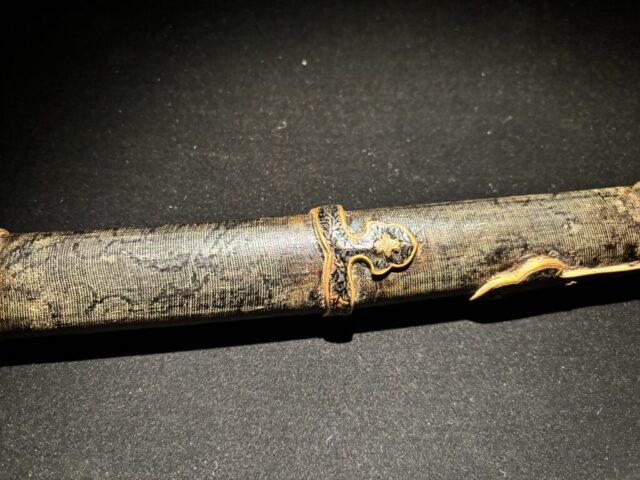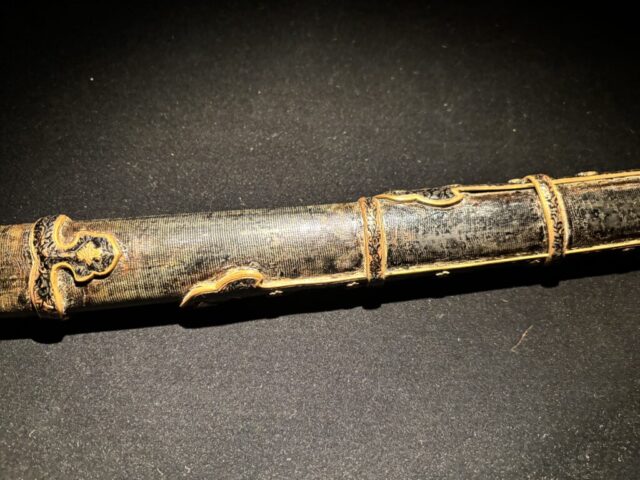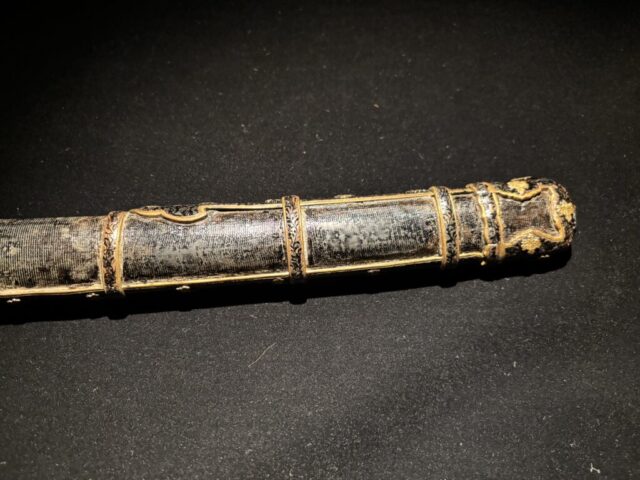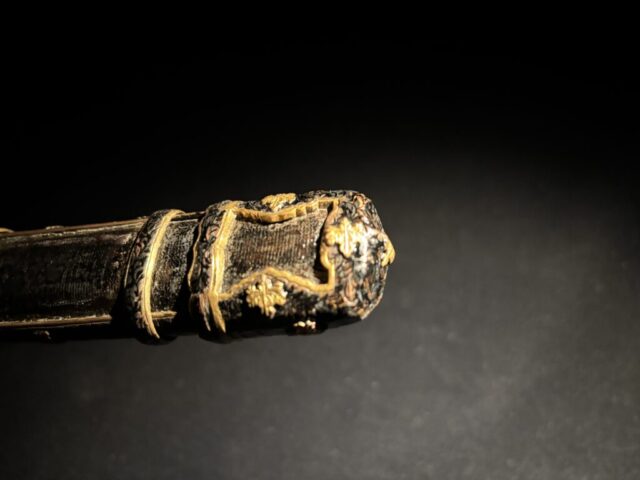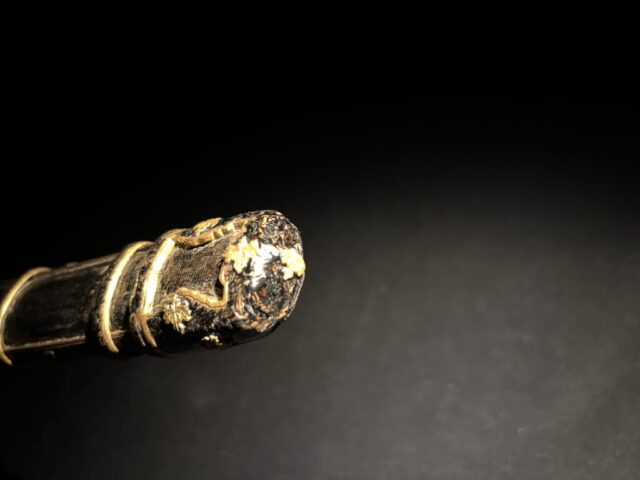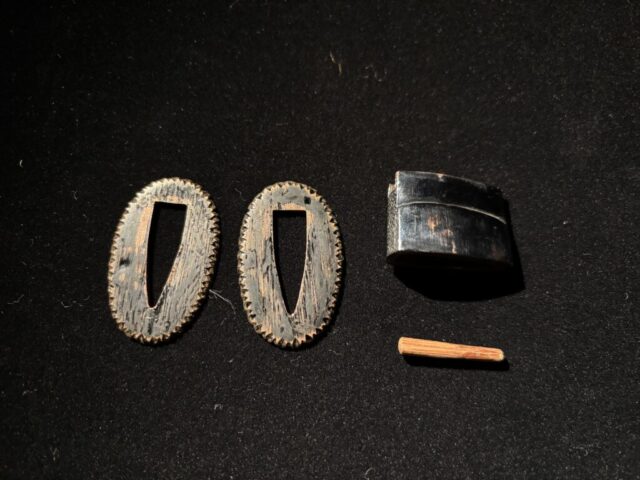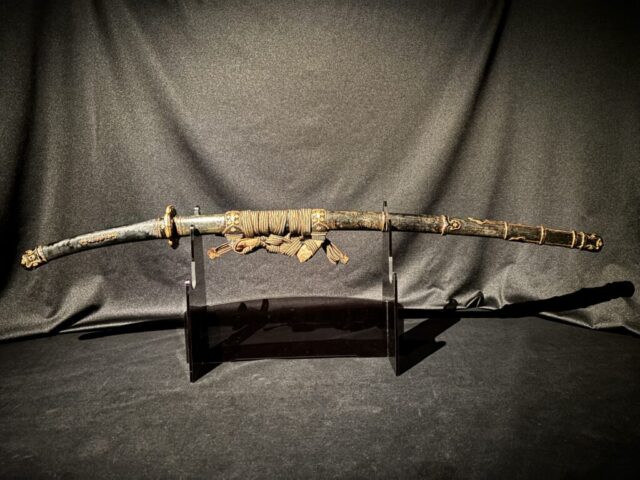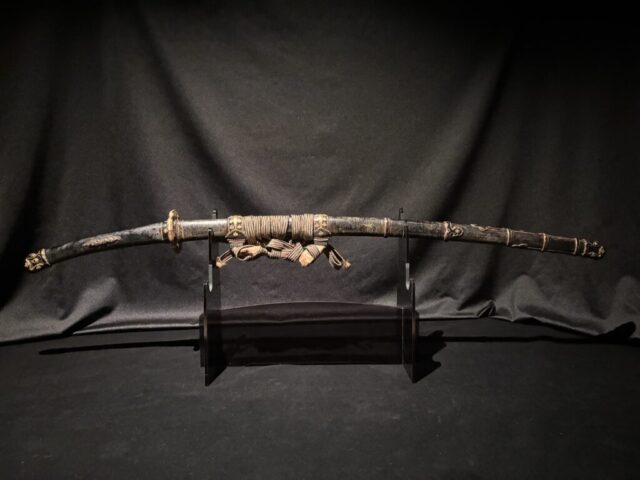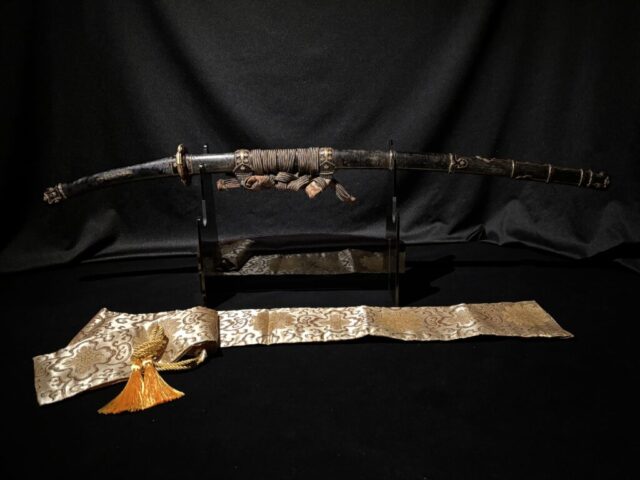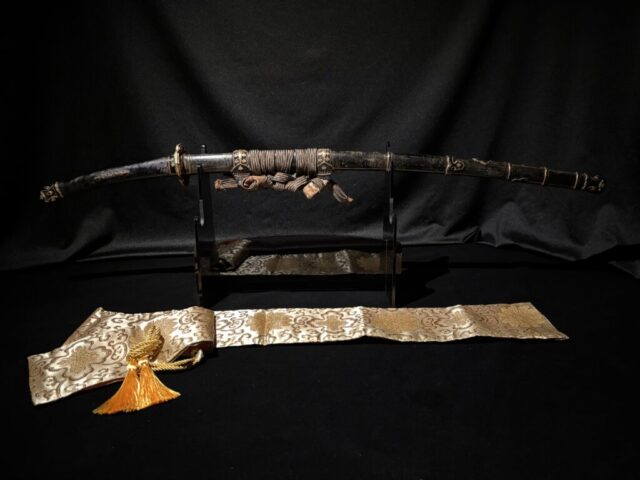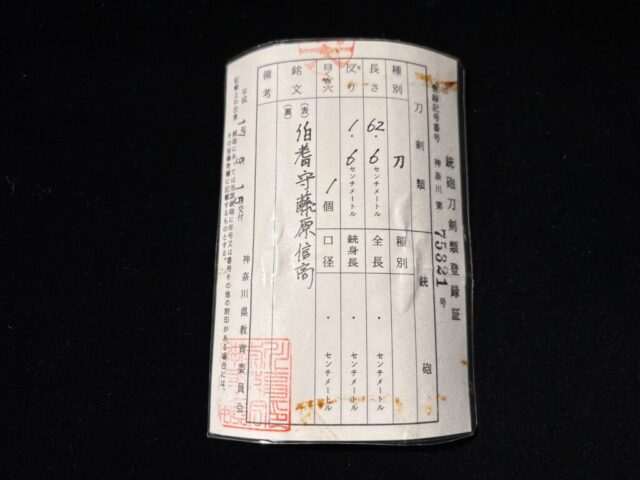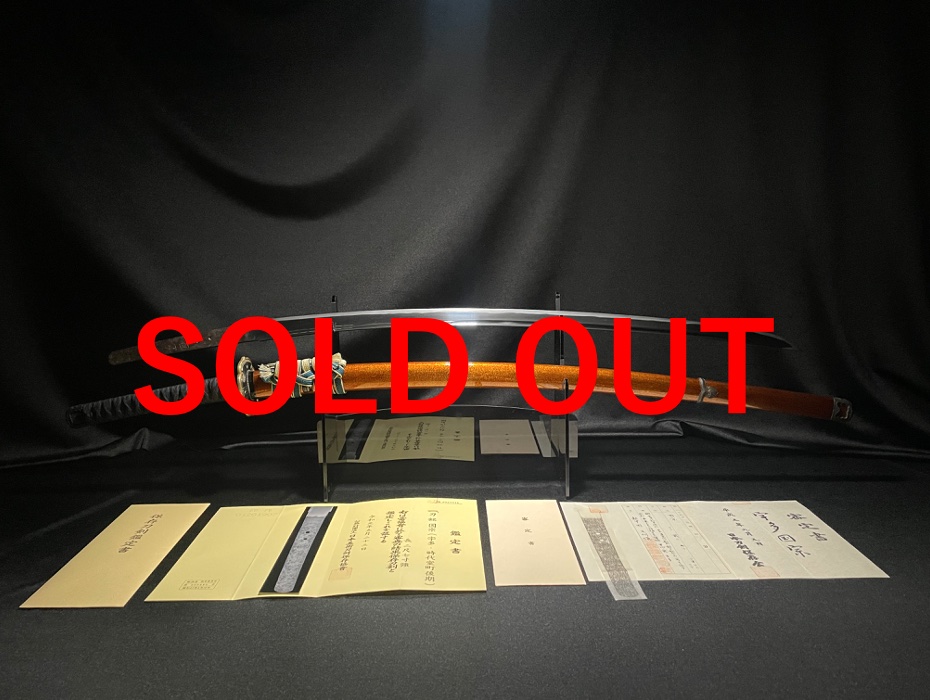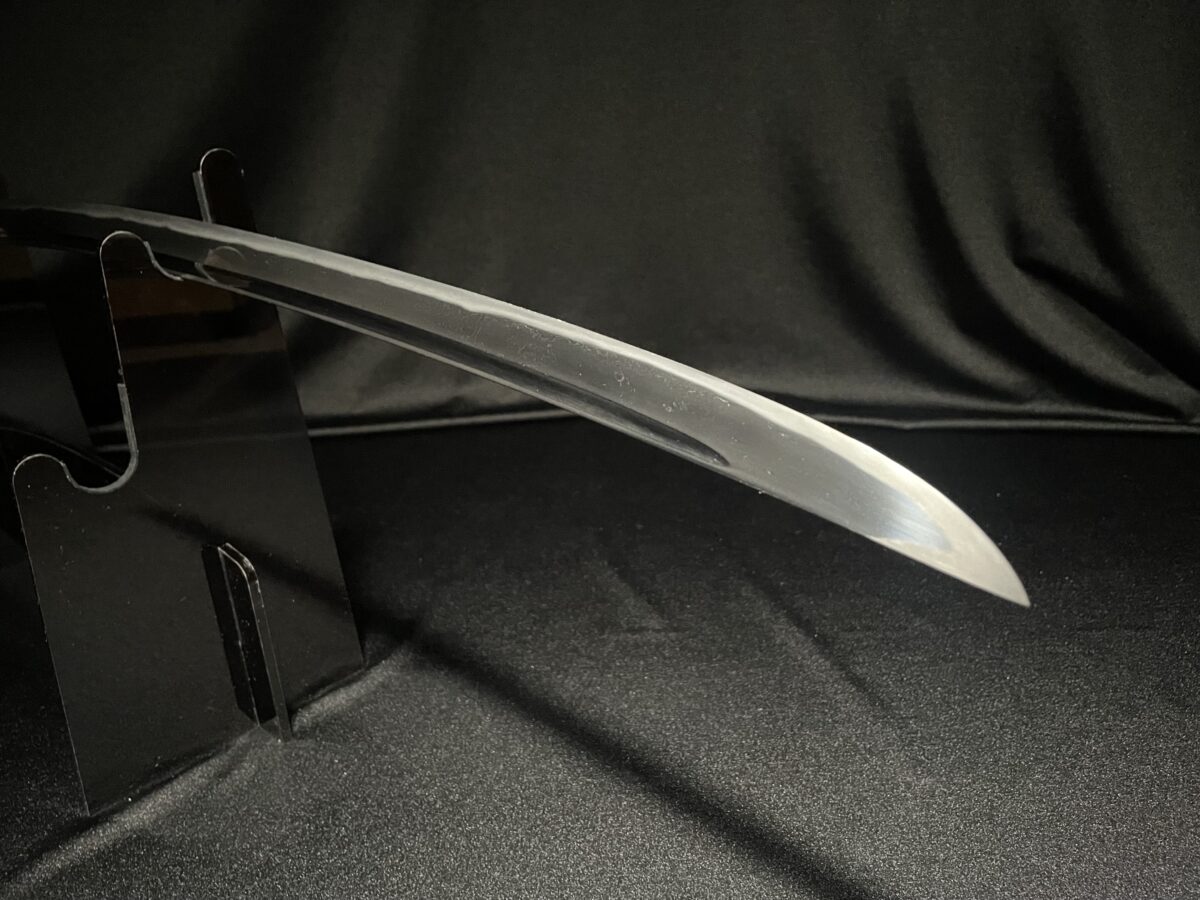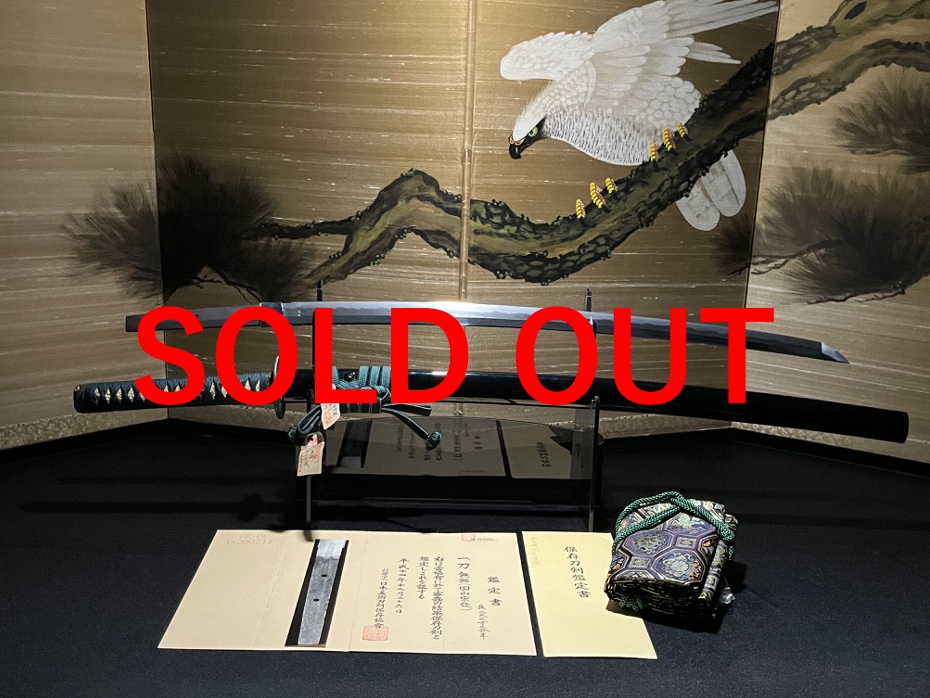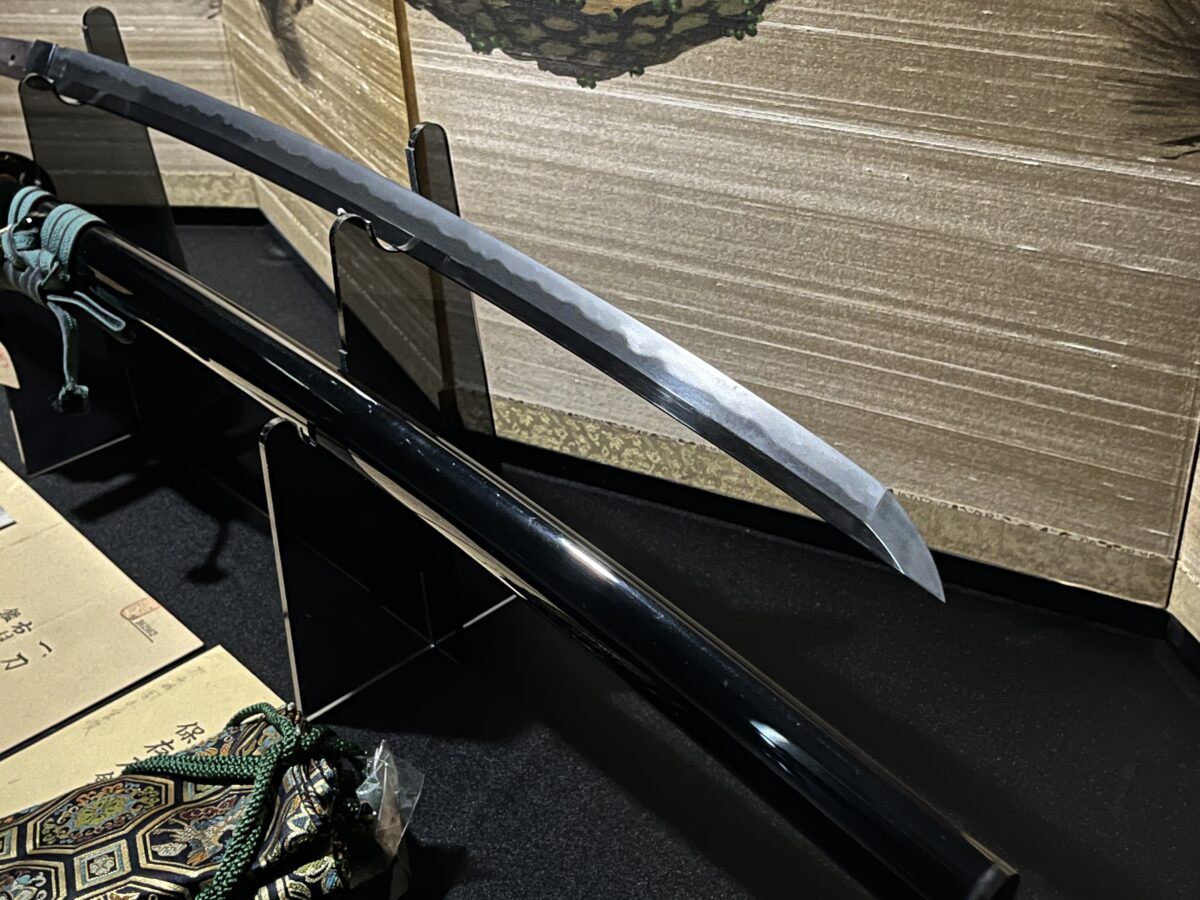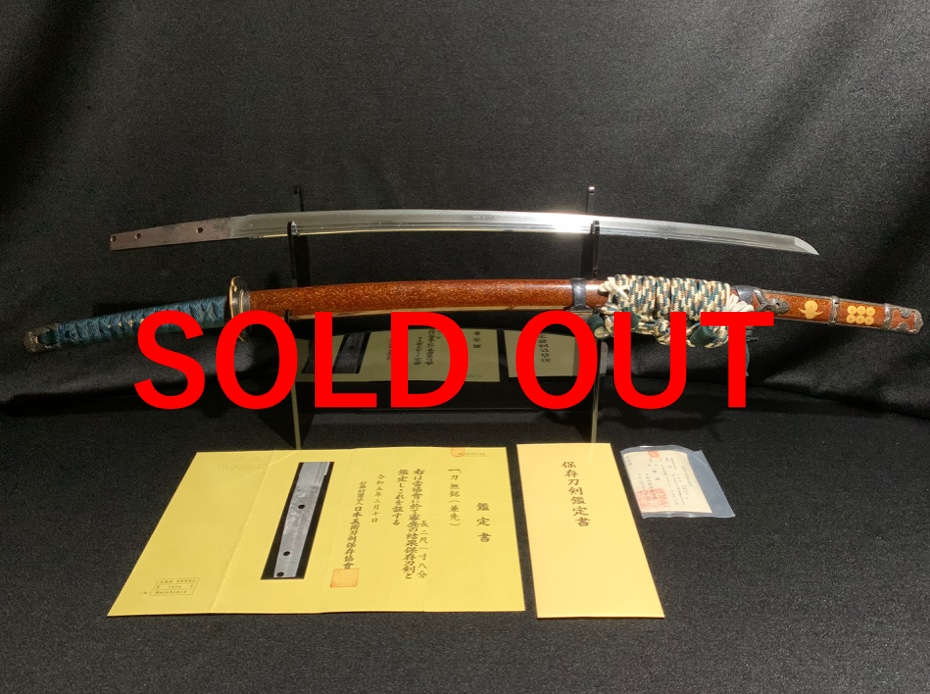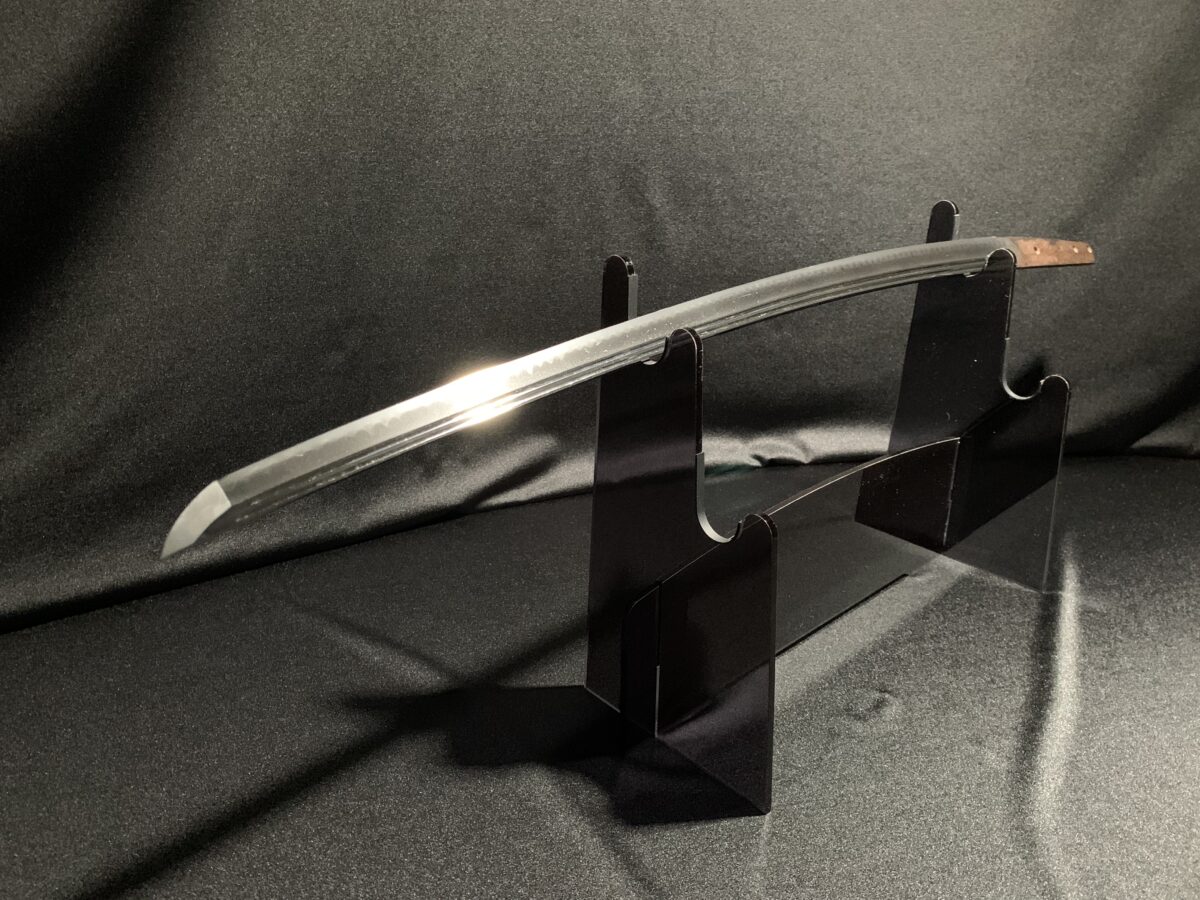Hokinokami Fujiwara Nobutaka(伯耆守藤原信高) – Authentic Katana(1610-1680)
Description
From the Katana Enthusiast

A Nobutaka Katana in remarkable condition.
In addition to its powerful blade, the piece features a distinctive Koshirae (拵え, sword mounting) with a refined, subdued design that evokes a strong sense of history.
Katana Registration
All Real Katanas are registered with the Board of Education of the prefecture in which they are located.
Please note that the original registration certificate must be returned to the Board of Education prior to export, but a copy will be enclosed with your purchase.
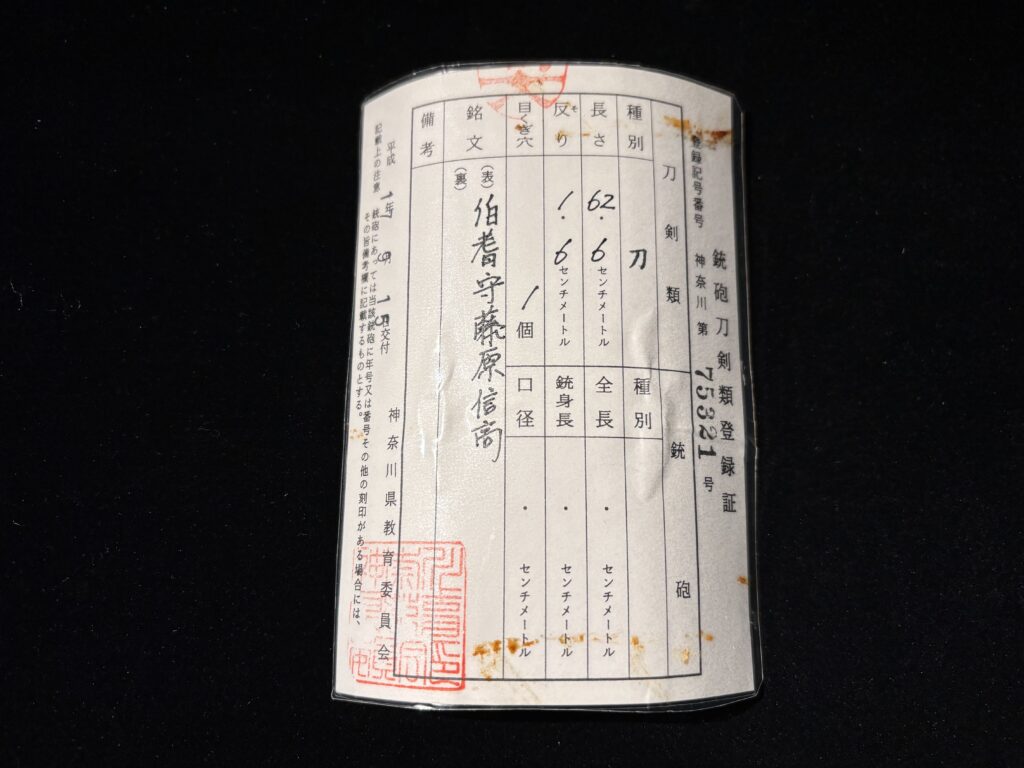
Each part of the Katana
1. Toshin(刀身)
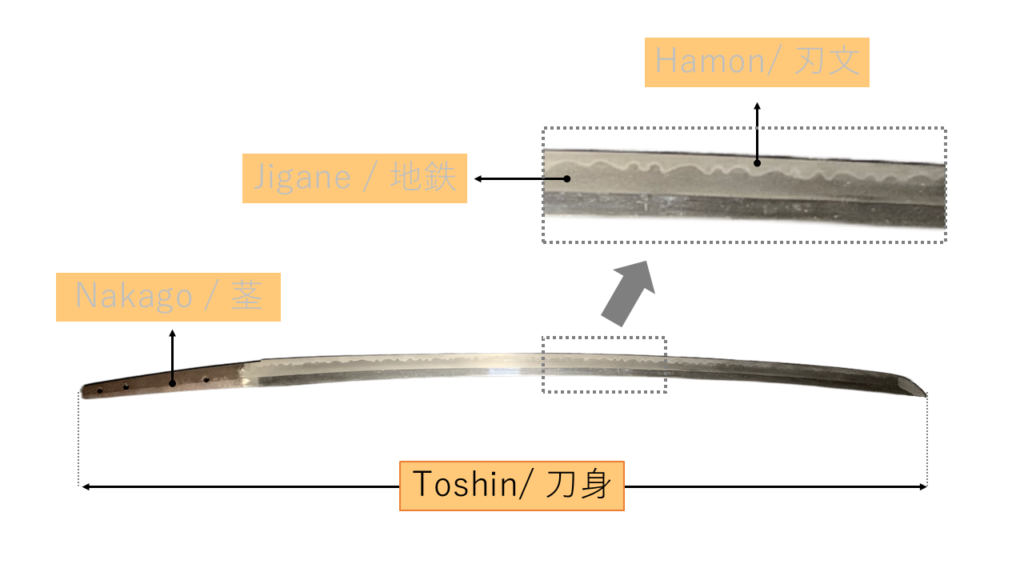
The Toshin refers to the entire blade of the Katana.
When evaluating a Katana, the blade’s length—and particularly its sori (curvature)—is a key point of appreciation.
The sori is what enables the Japanese sword to remain unbreakable and unbendable, while also allowing it to cut through objects with remarkable efficiency and minimal force.
If you’re interested in the scientific background of this, we explain the theory in detail in the following article:
Curved for a Reason: The Hidden Function of Authentic Katana’s Shape
【Toshin of This Katana】
Koshirae Full Length: 104.0cm
Overall Length : 77.9cm
Blade Length (Nagasa): 62.6cm
Width at Base (Motohaba) : 2.9cm
Thickness at Base (Motokasane) : 0.7cm
Weight : 0.6kg
Curvature (Sori): 1.6cm
2. Hamon(刃文)
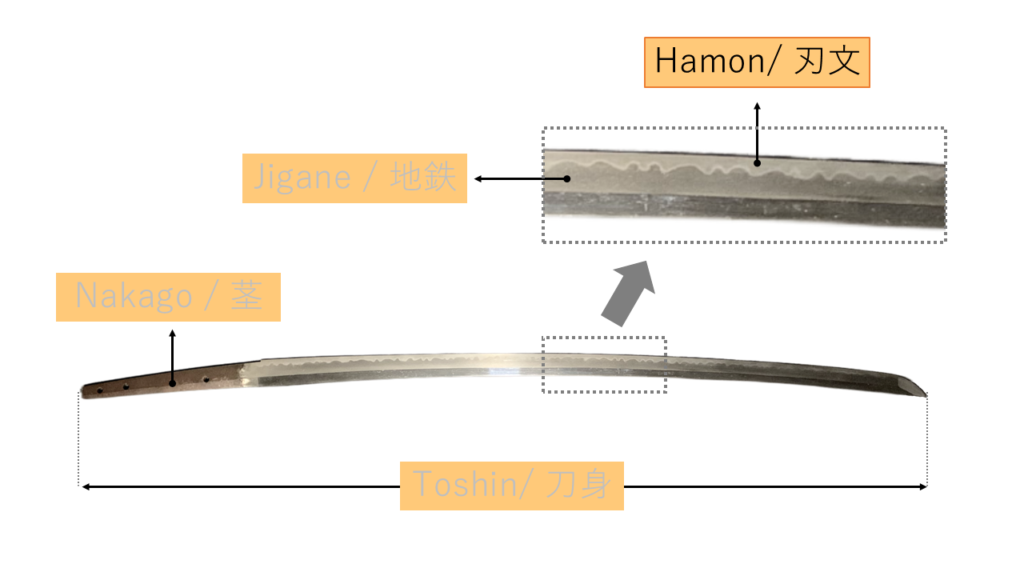
The Hamon is a white, wave-like pattern that appears along the edge of an authentic Katana blade.
There are two primary types of Hamon: the straight-line Suguha, and the more irregular, wavy Midareba.
While these can be further classified into many subtypes, the Hamon is a key element in sword appraisal, as it reflects the unique characteristics and techniques of the swordsmith.
It’s also one of the most visually enjoyable features of a Katana, making it fun to choose a blade based on the Hamon that resonates with you.
【Hamon of This katana】
3. Jigane(地鉄)
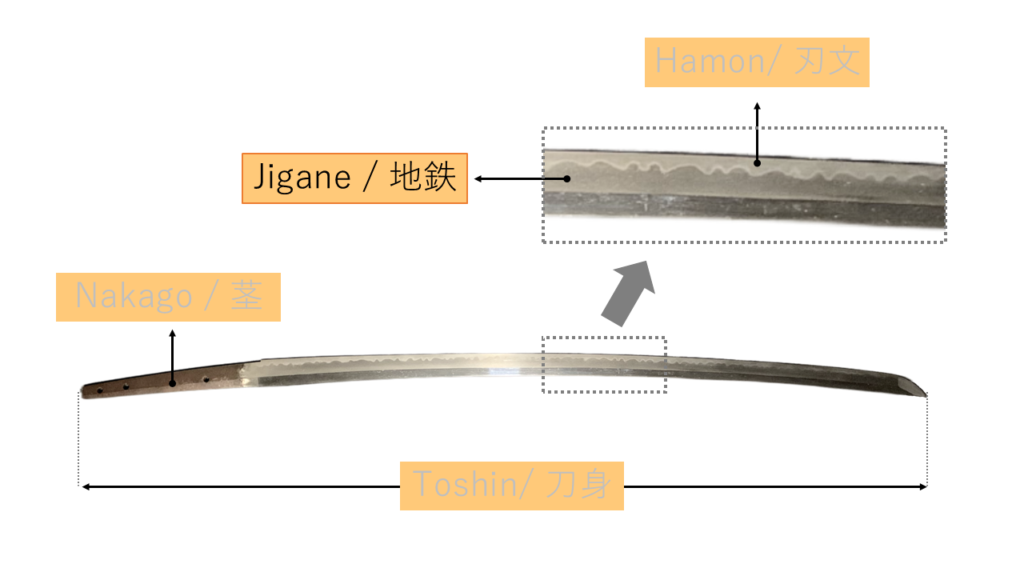
Jigane refers to the intricate surface patterns that appear on the blade of a Katana.
These patterns are created when tamahagane—steel made from iron sand, the raw material—is repeatedly folded and forged.
Each Katana reveals a unique Jigane pattern, offering a window into the artistry and technique of its maker.
【Jigane of this katana】
4. Nakago(茎)
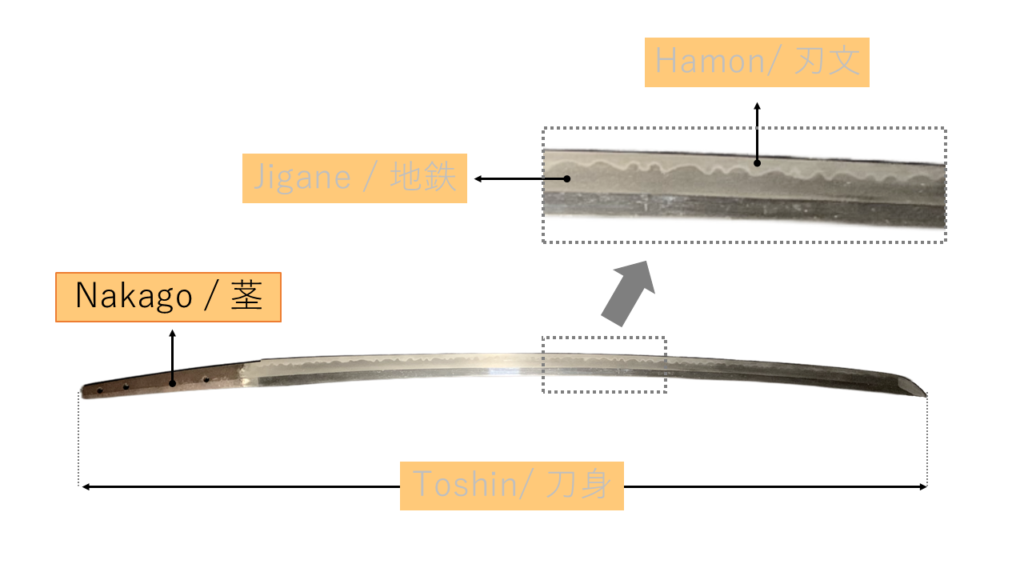
The Nakago is the tang of the Katana—the part of the blade that extends into the handle.
It often bears a mei (銘), or signature, which may include the name of the swordsmith and the date of its creation.
【Nakago of This katana】
5. Tsuba (鍔)
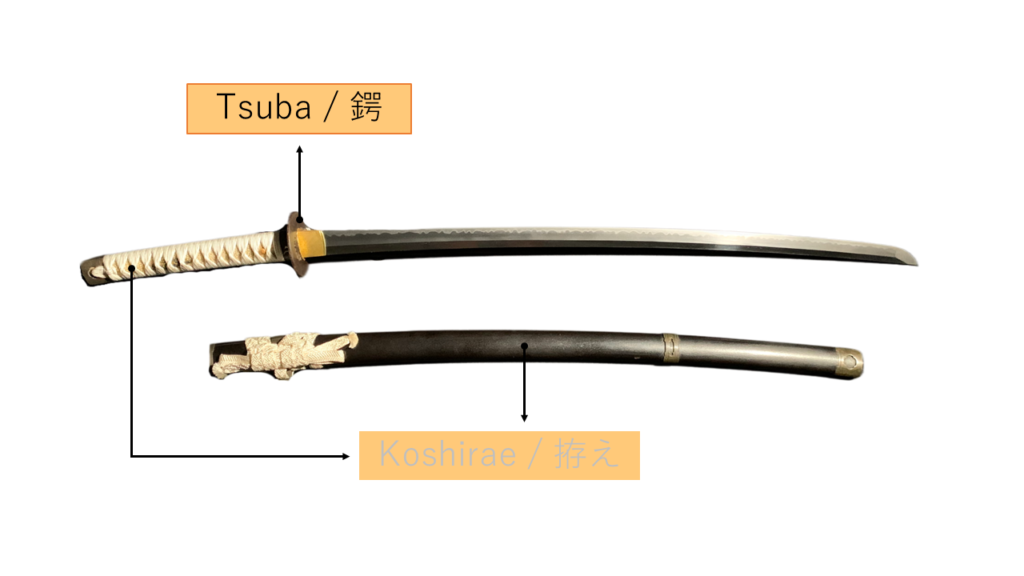
The Tsuba is a metal guard positioned between the Toshin (blade) and the handle. Its primary function is to protect the wielder’s hand from an opponent’s blade during combat.
Conversely, it also prevents the hand from slipping forward onto the blade during a strike.
In addition, the Tsuba helps to balance the Katana by adjusting its center of gravity.
There are many different styles of Tsuba, ranging from purely functional to highly decorative.
Some are so exquisitely crafted that they are recognized as valuable works of art—with certain Tsuba designated as Important Cultural Properties by the Japanese government.
【Tsuba of This katana】
6. Koshirae(拵え)
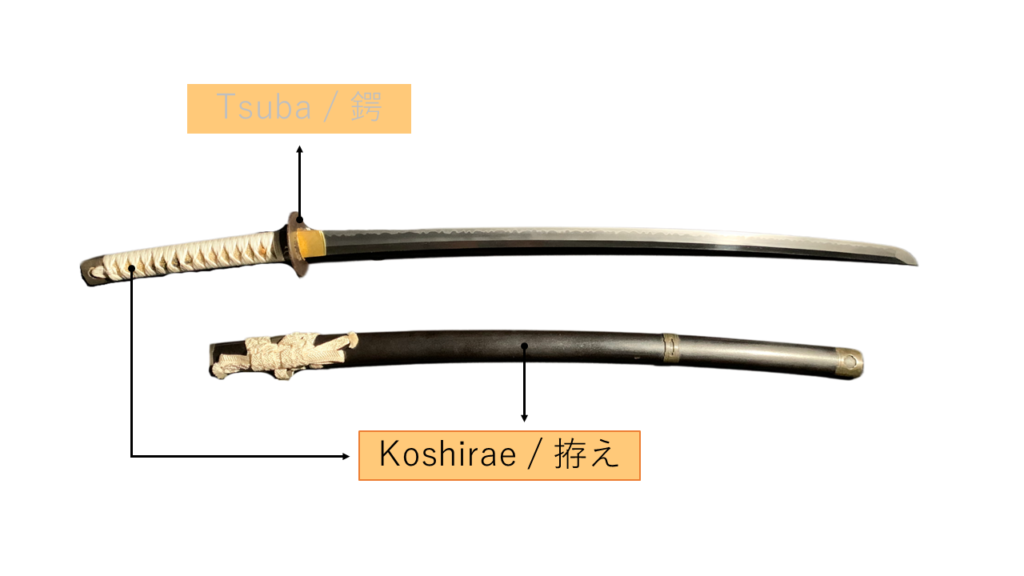
Koshirae refers to the complete exterior mountings of a Katana, including the handle (tsuka), guard (tsuba), and scabbard (saya).
There are two main styles of Koshirae: Uchigatana Koshirae (打刀拵) and Tachi Koshirae (太刀拵). Because each Katana differs in length, curvature, and proportions, a unique Koshirae is custom-made to perfectly match each blade.
The Koshirae itself is considered an important work of art.
We hope you’ll enjoy appreciating it as a complete expression of the Katana’s beauty and balance.
【Koshirae of This Katana】
About Hokinokami Fujiwara Nobutaka(伯耆守藤原信高)
Hoki no Kami Fujiwara Nobutaka (伯耆守藤原信高) was a leading swordsmith from Owari Province (present‑day western Aichi Prefecture) during the early Edo period. Originating from the Mino‑den tradition, he was born in Mino Province and later relocated to Owari around the time Nagoya Castle was completed in 1610.
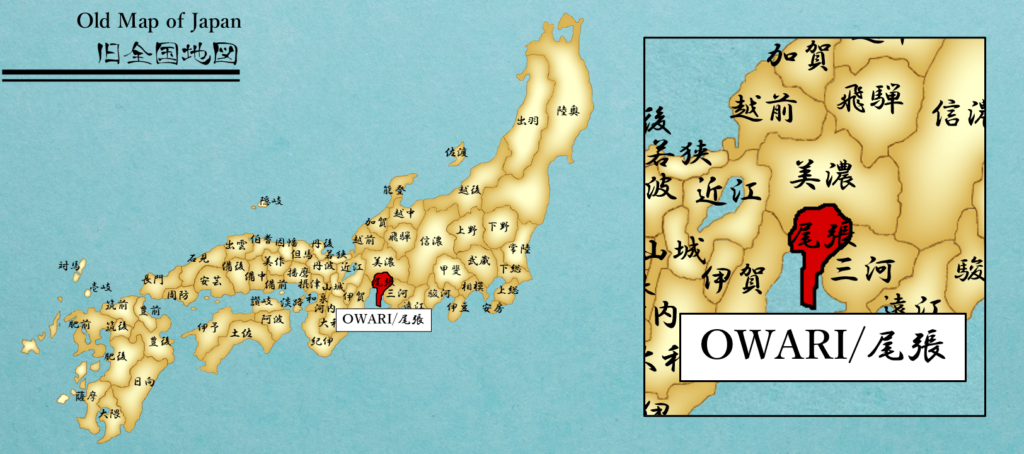
Nobutaka received the prestigious title of Hoki no Kami in 1581 and became a hereditary official smith for the Owari‑Tokugawa clan. The line continued through five generations of smiths carrying the same title under strong patronage from the domain.
He and his successors are celebrated as part of the “Owari-Seki” group—smiths of Mino origin active in Owari—and are regarded as exemplars of the Owari Shinto style.
From the Gokaden Lineage: Mino-den Roots
Many Japanese swords trace their roots back to one or more of the five major traditional schools of swordsmithing, known as the Gokaden(五箇伝).

These five traditions—Yamato, Yamashiro, Bizen, Soshu, and Mino—each developed in different historical provinces and are known for their distinct styles and characteristics.
This sword is rooted in the Mino-den(美濃伝) tradition.
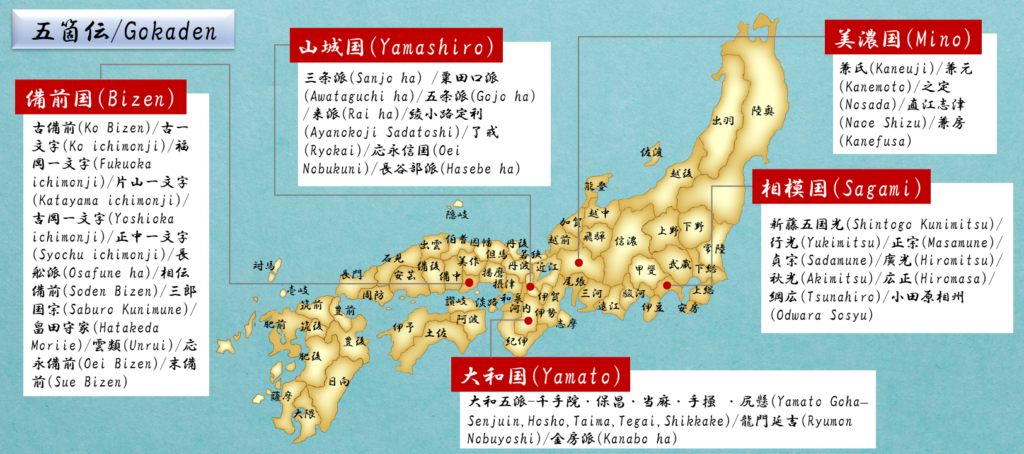
Mino-den emerged in Mino Province (present-day southern Gifu Prefecture) in the early Muromachi period. With the rise of the Sengoku era and the increasing demand for functional swords, Mino swordsmiths gained prominence by producing high-quality blades optimized for actual combat, often on a large scale.
The region saw an influx of smiths influenced by Yamato-den and Yamashiro-den traditions, and the fusion of these techniques contributed to the development of Mino’s practical and balanced sword-making style.
In particular, the town of Seki became a major hub, giving rise to a large number of smiths whose works became widely known as Seki-mono (関物, Seki swords).
Rather than focusing on flamboyant visual flair, Mino swords are appreciated for their structural beauty and practicality, with a strong sense of reliability and balance. This tradition’s emphasis on function, combined with its rich historical background, makes Mino-den swords highly attractive—both for first-time buyers and seasoned collectors alike.
Buyer’s Guife
Authentic Katanas are limited in number, and we hope each one finds its way to a collector who truly appreciates its value.
Before making a purchase, please take a moment to review our [Buyer’s Guide] for important information.
Shipping Information
1.Time Required for Delivery
This is a truly domestic Japanese sword that has never left Japan.
In order to export it overseas, we must obtain an official export permit from the Agency for Cultural Affairs of Japan.
It typically takes around 25 business days from the time of payment until the export process begins.

After shipment, delivery usually takes 7 to 20 days, depending on the destination country.
2.Shipping Charges
Shipping is free of charge.
We offer international shipping to most countries, with the exception of China and Russia.
3.Regarding Imports
Please check with your local customs office regarding regulations on importing Japanese swords.
We are not responsible for delays, rejections, or seizures by customs in the destination country.
For more details, please refer to our dedicated [Shipping Information] page.
Payment
You may complete your purchase via PayPal or by making a direct bank transfer to our account.
All prices are tax-exempt and do not include Japanese consumption tax, as this policy applies to international purchases only.
Please note that customs duties or import taxes may apply depending on your country’s regulations.
Buyers are responsible for any such charges.
For more details, please refer to our dedicated [Payment] page.
Frequently Asked Questions (FAQ)
If you have further questions, feel free to contact us directly.
Do you ship internationally?
Yes, we ship authentic Japanese swords worldwide. Even if we do not have a delivery record to your country, we will do our best to arrange secure delivery.
Currently we do not ship to China or Russia.
Is shipping really free?
Yes. All listed prices include complimentary international shipping. No additional delivery fees will be charged.
How long will it take to receive my sword?
Because we must obtain export approval from Japan’s Agency for Cultural Affairs, it takes about 25 business days to begin shipping. Including transit time, please allow 1–2 months for delivery.
Are the swords already exported items?
No. Every sword we offer has remained in Japan since its creation and is being exported for the first time.
Are the swords legally exported?
Absolutely. We follow all Japanese regulations and obtain official export permits before shipment.
Do I have to pay customs duties or taxes?
Import duties or taxes may be levied by your country’s customs authority. Buyers are responsible for any such charges. Please check locally in advance.
Can I return a sword after purchase?
Returns and exchanges will not be accepted unless agreed upon between the Company and the User.
How do you select the swords you sell?
Our team consists of katana enthusiasts with backgrounds in metallurgy and history. We hand-select each blade for authenticity, condition, and cultural value.
How can I trust that the sword is real?
All swords are genuine antiques, many with registration or appraisal documents. We do not handle replicas or mass-produced blades.
Are these swords actually sharp and functional?
Yes. Our swords are authentic Japanese katana forged by traditional methods and possess a level of sharpness that has been revered for centuries. They are not decorative replicas—they are real blades capable of cutting. Please handle with the utmost care to avoid injury or damage.
I’m looking for something specific. Can I request it?
Certainly. Please contact us with your requirements—design, smith, school, era, condition—and we will be happy to assist.

